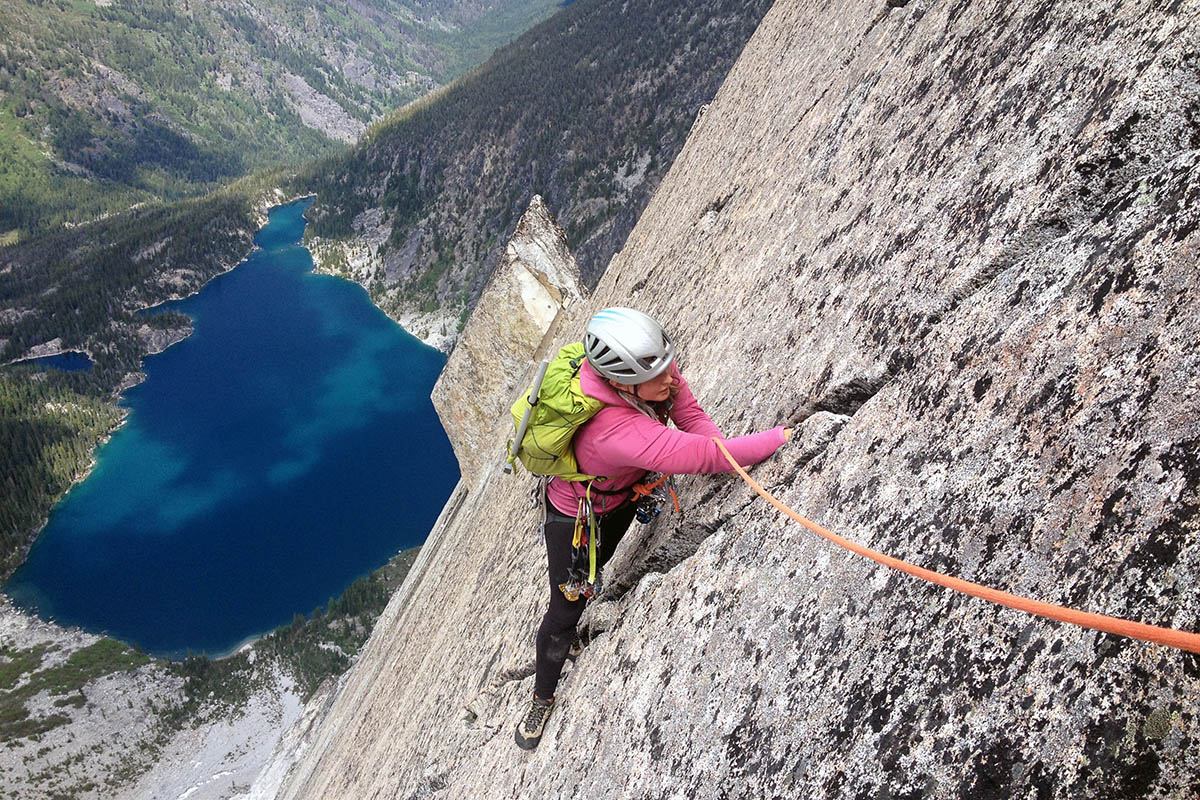
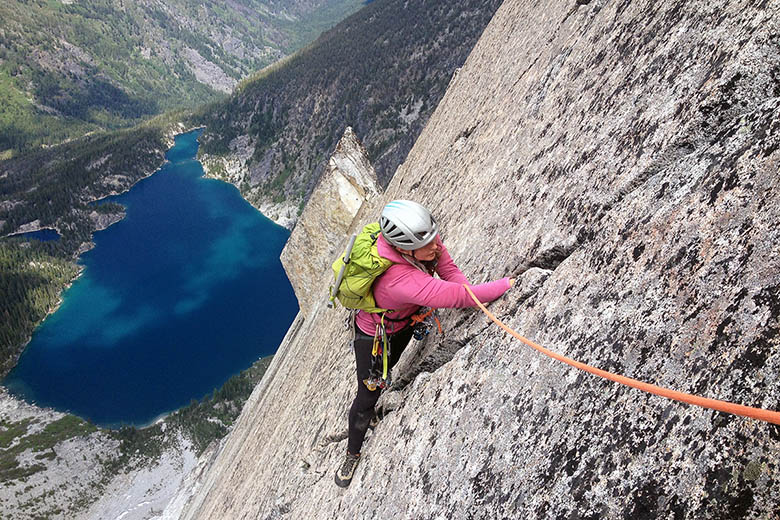
Switchback Travel


Switchback Travel
Gone are the days when climbing consisted of swami belts, hobnailed boots, and weeks spent nailing pitons into swaths of granite. Current trends in climbing gear have moved toward functionality, performance, and thoughtful design, and packs have followed suit. In this article, we break down the top climbing backpacks of 2025 into three categories: crag, follower, and alpine. Each balances different demands, but these packs all share a focus on organization (whether inside or out) and generally are lightweight and durable. For more background information, see our comparison table and buying advice below the picks, along with details about our testing process.
Editor's note: We updated this guide on May 19, 2025, to add the Hyperlite Halka 55 as our favorite pack for mountaineering following extensive testing in Nepal. We also added the Black Diamond Pipe Dream 45 to the list, freshened up the photos with shots from recent adventures, and ensured all other information was up to date at the time of publishing.
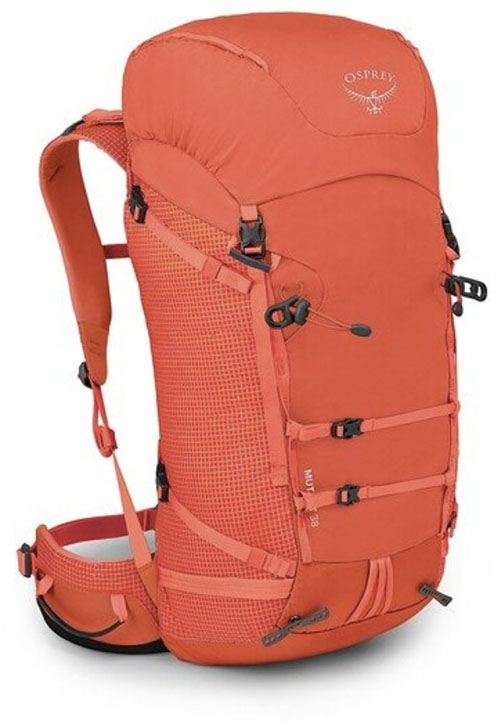 Category: Alpine/crag
Category: Alpine/crag
Weight: 2 lb. 8.3 oz.
Capacities: 22, 38, 52L
What we like: Accommodates heavy loads well; extremely versatile.
What we don’t: Heavier than most alpine packs and the hipbelt is not removable.
To be honest, we didn’t think we’d ever see an Osprey—a favorite brand among backpackers and hikers—at the top of a climbing article, but we stand corrected. Their alpine-specific Mutant was quick to impress, combining class-leading comfort with an array of technical features and a customizable—but not overly complex—build. This is a year-round, do-all pack that is up to the task whether you’re ice climbing, mountaineering, cragging, approaching a multi-pitch climb, or even skiing. And with the latest update, it’s now built with even more hardwearing and environmentally friendly materials, including recycled nylon and a PFAS-free water-repellent coating. For a one-quiver wonder that offers a much more user-friendly experience than most sleek alpine packs, it’s well worth a closer look.
If your definition of climbing encompasses mountains or long approaches in addition to cragging, the Mutant 38 will serve you well. But not all climbers need such a versatile design: Most sport climbers will be better off with a haul-bag-style pack like the Creek 50 below, while the light-and-fast crowd will want to save weight with a stripped-down design (like the Arc'teryx Alpha FL or Mountain Hardwear Alpine Light below). It’s also worth considering the 52-liter Mutant, which offers a larger capacity for trad or overnight gear, along with the 22-liter follower pack. Regardless of capacity, the Osprey offers a great combination of comfort and features for a range of climbing styles. For a lighter and more streamlined alternative, we also love Mountain Hardwear's Alpine Light below, although it's pricier at $275.
Read more: Osprey Mutant 52 review
See the Osprey Mutant 38
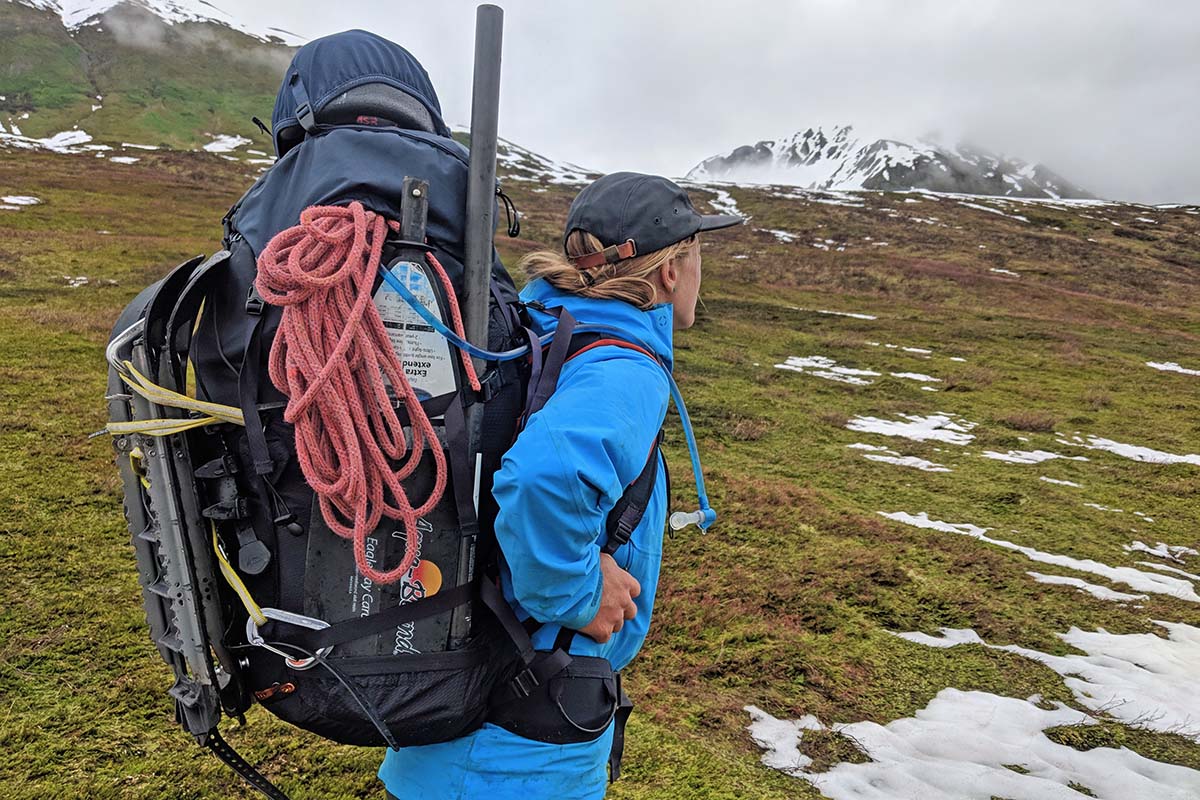
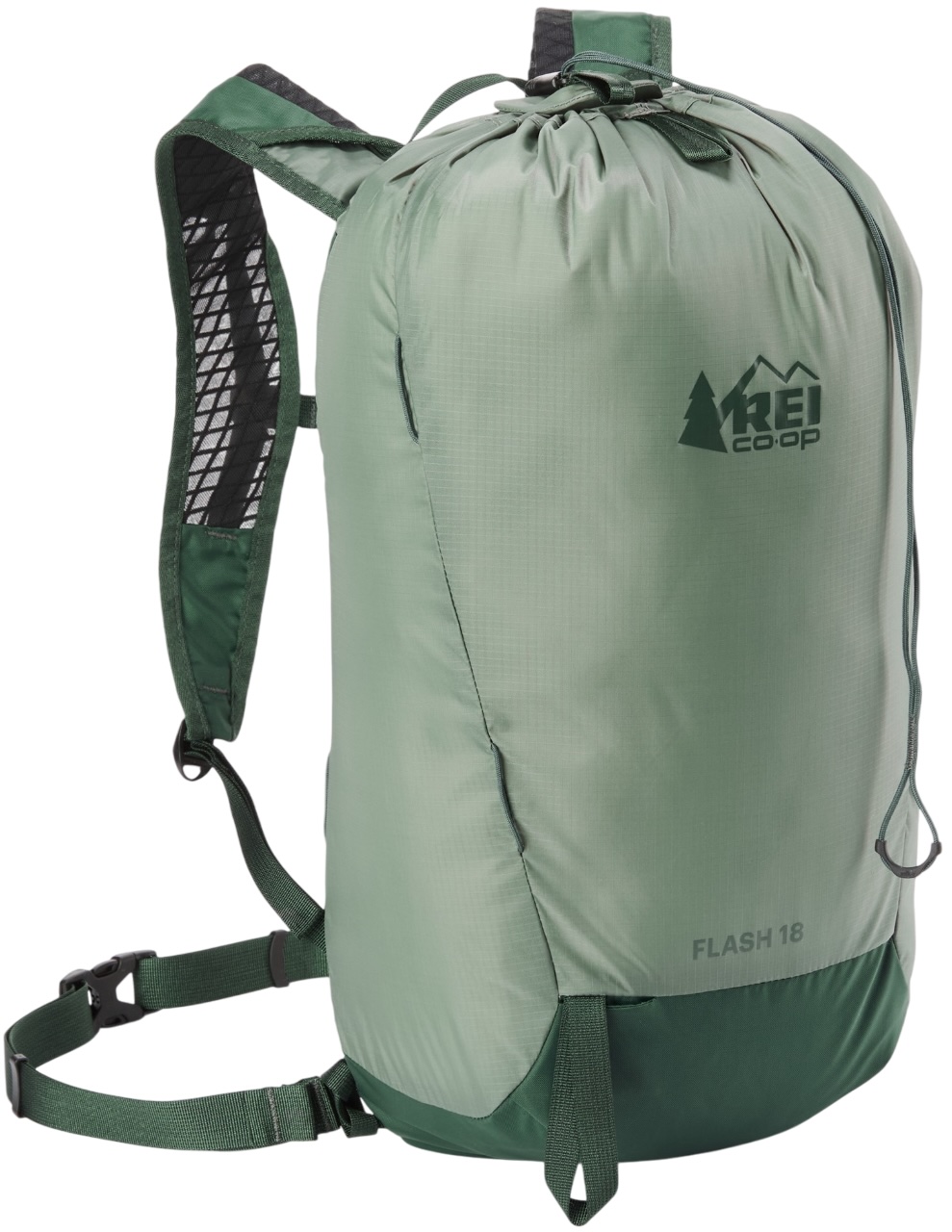 Category: Follower
Category: Follower
Weight: 9.5 oz.
Capacities: 18, 22L
What we like: Affordable and lightweight with an impressively functional feature set.
What we don't: Thinner and less durable than the competition.
We know what you’re thinking: REI? A climbing pack? The answer is a resounding “yes.” In addition to being the cheapest model on our list, the Flash 18 is also the lightest but still manages to include a bunch of useful features. Like many other follower packs, the Flash has a top drawcord that can be opened and closed one-handed, a backpanel that can be taken out and used as a sit pad, removable hip and sternum straps, and even daisy-chain attachment points and an ice axe loop. For $40 and just 9.5 ounces, that's a whole lot of pack.
But despite its impressive weight and price, the Flash 18 does have its downsides, most notably in terms of durability. The thin nylon construction pales in comparison to more rugged follower packs like the Black Diamond Rock Blitz below (for reference, the Flash uses a 70D fabric, while the BD is a whopping 840D). It is not made to be hauled up routes, won’t last long in chimneys, and is bound to get ripped if you’re loading it down with sharp climbing gear on the walk out. But for $40, the Flash is undeniably an excellent value, and its feature set is surprisingly functional for climbing. For those willing to trade a bit more bulk for added storage, REI also makes the Flash 22 ($60; 14 oz.), which boosts capacity by 4 liters and includes stretchy dump pockets on each side, a handy top lid with a zippered compartment, and more substantial padding along the straps and backpanel.
Read more: REI Co-op Flash 22 review
See the REI Co-op Flash 18
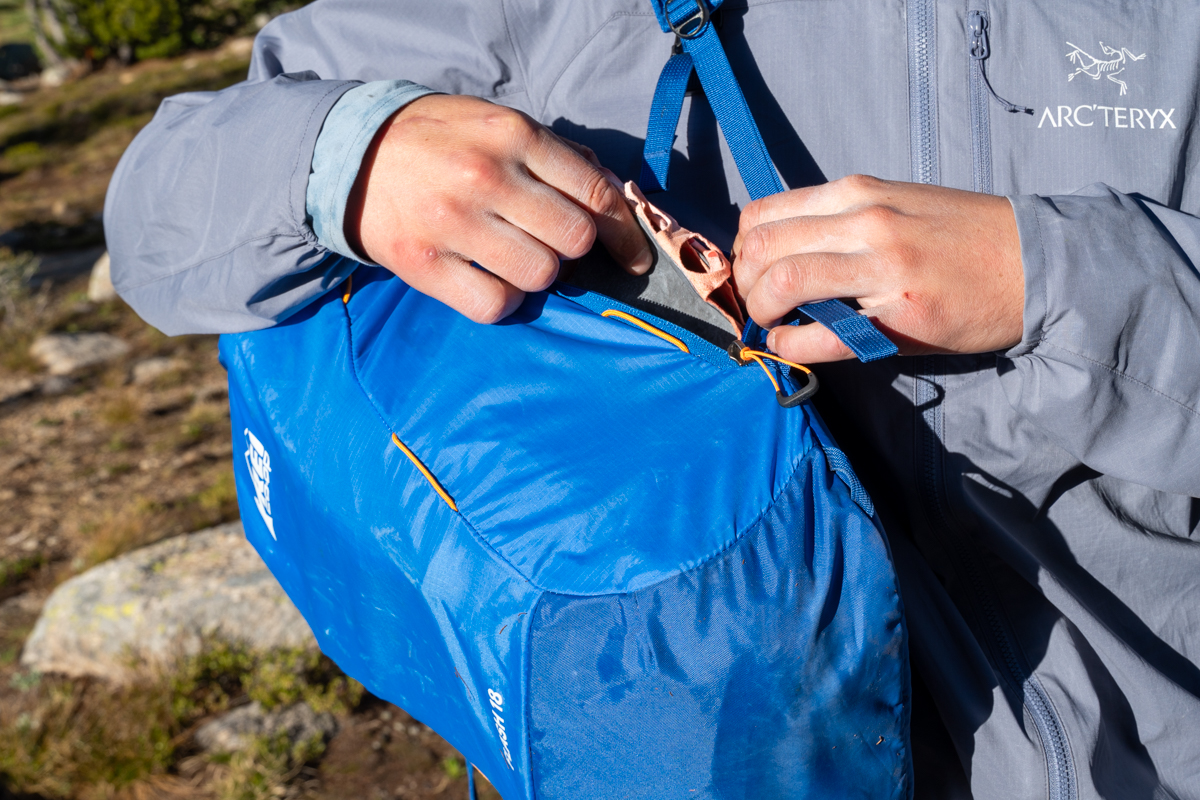
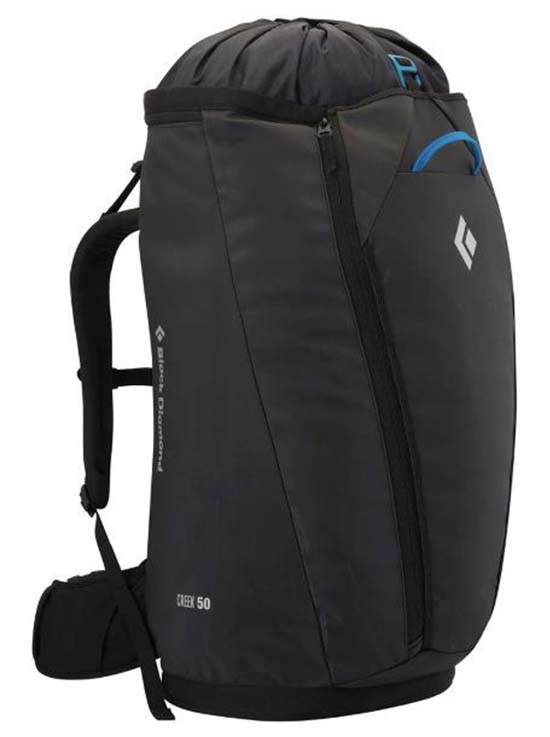 3. Black Diamond Creek 50 ($240)
3. Black Diamond Creek 50 ($240)Category: Crag
Weight: 4 lb. 6.7 oz.
Capacities: 35, 40, 50L
What we like: Easy to pack and ridiculously durable.
What we don’t: The cavernous compartment can feel like a black hole.
If you’re anything like the average climber, you most likely spend more time at the crag than multi-pitching or schlepping into the mountains. And while any old pack will work for short hikes with a sport or trad kit, Black Diamond’s Creek 50 workhorse is by far our favorite tool for the job. This black hole of a pack boasts a flat base for upright loading and unloading, a convenient front compartment with two zippered pockets for divvying up smaller items, and full side-zip access to the main compartment—great for accessing items at the bottom of the bag without removing everything on top. The Creek 50 also has the most durable fabric (1,200D polyester) of any model here, making it the ideal rig for day-in, day-out use at the crag.
The Creek 50 is one of the most rugged and well-built crag packs, but unless you consistently carry a massive trad rack, you may find its 50-liter capacity to be excessive. Black Diamond also makes their Crag 40: a lightweight, streamlined version of the Creek that’s $90 cheaper but far less durable. It also might be worth considering duffel-style packs like Black Diamond’s own Stone 42 or the Patagonia Cragsmith below. Both allow for easier access to your gear, but the simpler Creek is easier to pack and has fewer breakable parts (we’ve been using ours for almost a decade, and it’s still going strong). Added up, the Creek 50 is the gold standard among crag packs and well worth its $240 price tag.
See the Black Diamond Creek 50
.jpg)
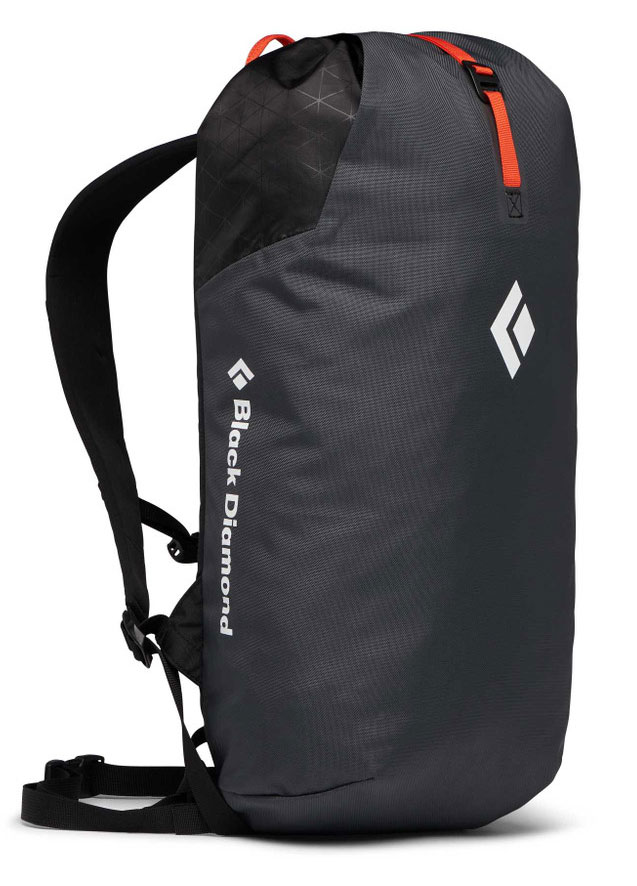 Category: Follower
Category: Follower
Weight: 14.2 oz.
Capacity: 15L
What we like: Very durable and great shape for hard climbing.
What we don’t: Pricier and heavier than the REI Flash below.
The Black Diamond Rock Blitz is a purpose-built follower pack for rock climbers, ideal for carrying a day’s worth of supplies up long routes in areas like Red Rock or Squamish. You get impressively durable materials that can handle the ins and outs of multi-pitch routes (chimneys included), along with a foam-padded backpanel and shoulder straps to keep you comfortable. Shaped like a bullet, the Rock Blitz rides high on the back, close against the body, and out of the way of a harness, allowing you to climb unencumbered. And at the belay, you can access all of your snacks and layers via the top opening—which cinches closed with a one-handed drawstring—or via the small side zip pocket.
Made with durable 840-denier (D) nylon, the Rock Blitz offers a lot of durability in a small package. Of course it’s no match for a tried-and-true haul bag (especially if you’re tagging your pack up the route), but it will hold up significantly better than most follower packs like the cheaper REI Flash above. Further, at 14.2 ounces, it is streamlined enough to stuff away into a larger pack on the approach, and you can also remove the hipbelt and sternum strap to shave even more weight. Black Diamond also offers the more alpine-oriented Blitz pack, which comes in two capacities (20L and 28L), is built with thinner and lighter 100D fabric, and features ice tool attachments and a removable foam backpanel. But for the best combination of durability and affordability in a no-frills yet functional package, we turn to the Rock Blitz.
See the Black Diamond Rock Blitz 15
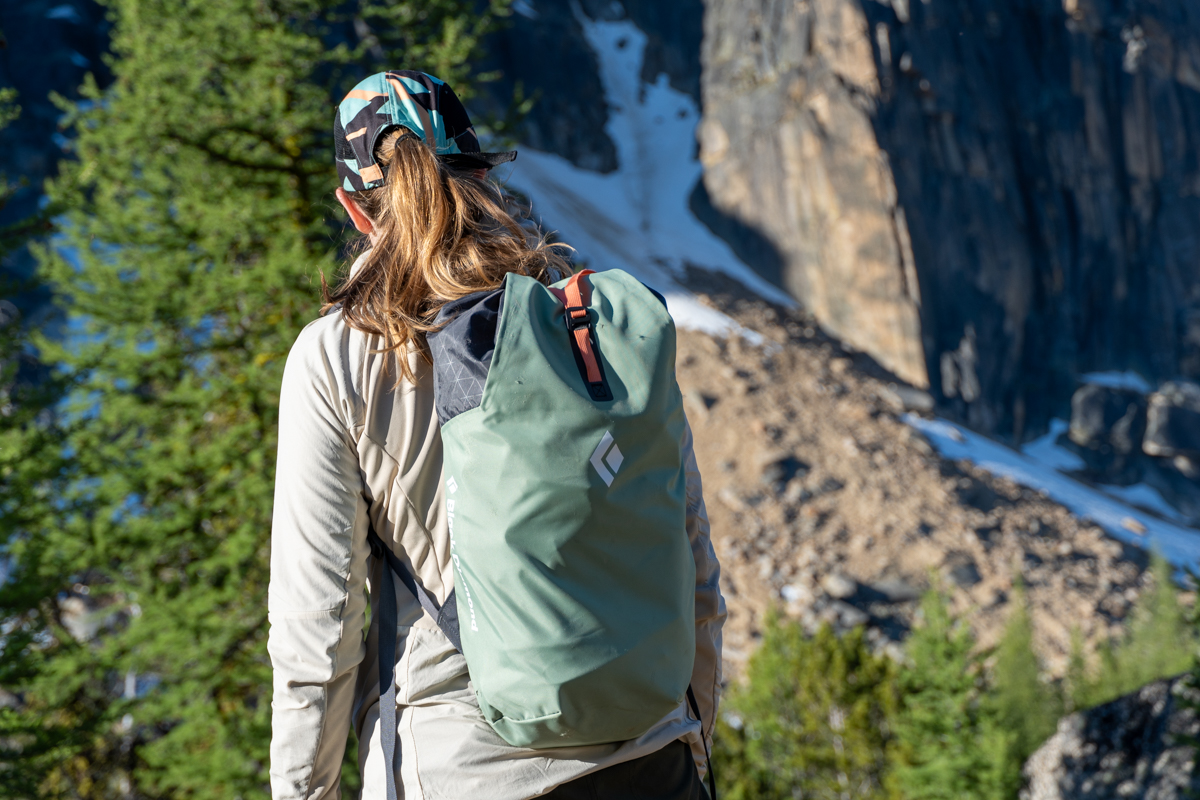
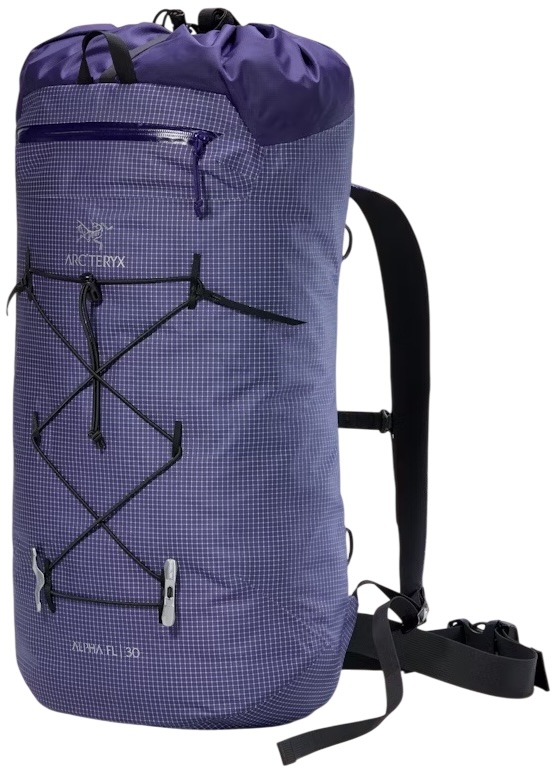 Category: Alpine
Category: Alpine
Weight: 1 lb. 6.9 oz.
Capacities: 20, 30L
What we like: Great durability, comfort, and waterproofing in a minimalist package.
What we don’t: Compromised carrying comfort and only comes in one size.
To create the ultralight Alpha FL, Arc’teryx merged the lidless, top-loading design of a follower pack with a rugged, medium-capacity bag. This pack is an alpinist’s dream: It's streamlined and lightweight, carries well, and is both waterproof and highly abrasion-resistant with a 315D laminated nylon construction. For mountain climbers’ varying storage needs, the Alpha FL expands to 37 liters for the approach and packs down to a 30-liter (or smaller) jet pack-like shape when the going gets technical. Additionally, accessing the contents is a breeze—even with gloves on—and lash points, bungee attachments, and a top strap secure anything from a rope and crampons to a sleeping pad and extra layers to the exterior.
The most recent iteration of this pack drops 2 liters of capacity in the main compartment but includes a larger front pocket, an additional internal pocket, revamped shoulder straps, and the use of Arc’teryx’s proprietary—and highly abrasion-resistant—gridded Hadron fabric. But many of the prior model’s trade-offs remain, including a slender shape that doesn’t accommodate bulky items, a thin (i.e., not very supportive) webbing hipbelt, and a pared-down exterior with very few organization options. And unfortunately, the Alpha FL only comes in one size, which can be limiting for those with particularly small or large frames. But if the fit works for you, the Alpha FL stands out as one of the most fully functional and well-built designs for alpine-style missions.
See the Arc'teryx Alpha FL 30
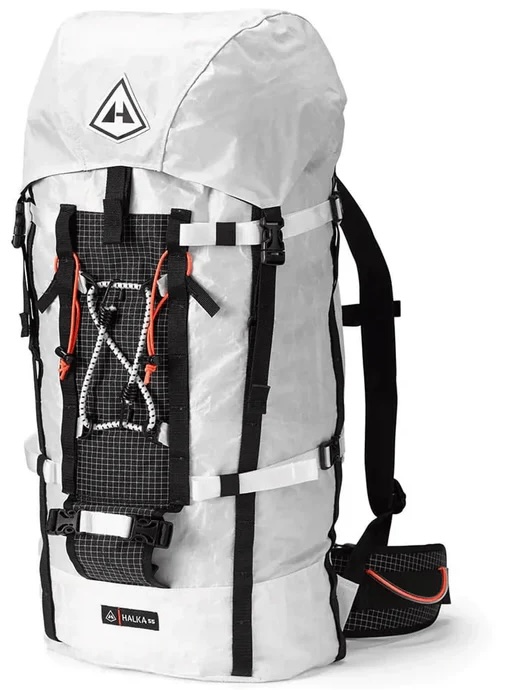 Category: Alpine
Category: Alpine
Weight: 2 lb. 11.5 oz.
Capacities: 55, 70L
What we like: Impressive feature set at a low weight; durable and comfortable under heavy loads.
What we don’t: Flimsy load lifters, steep price tag, and one of the hooks on our pack pulled off the bungee strap.
We’re always a bit skeptical of ultralight mountaineering gear. Often, it holds your life in its hands, and a mid-trip failure carries more dire consequences than backpacking gear. However, the Halka assuaged our fears. The DCH150 fully woven Dyneema fabric is bombproof while keeping weight and bulk to a minimum, making it an ideal companion for tough mountaineering missions. To thoroughly test the Halka, we brought it on an 80-mile trek in Nepal and climbed Imja Tse at over 6,000 meters. Carrying all our climbing/backpacking gear at ever-increasing altitudes, we were able to truly gauge its merit—and it impressed us more than we had anticipated. The shoulder harness is incredibly comfortable compared to other Hyperlite packs we’ve tried, and the feature set is purely utilitarian. It has all the essentials you need for an epic expedition without the weight and bulk of many traditional, high-altitude mountaineering packs.
A few headliners include an internal daisy chain designed to secure an oxygen tank with Voile straps, side sleeves for carrying more tanks on the 70-liter version, and a practical hipbelt with one zippered pocket and a gear loop. Standard alpine-ready features round it out: dual ice axe attachments, a crampon bungee strap, four external daisy chains, and additional daisy chains on the shoulder straps for lashing gear. In testing, we found the pack performed quite well at altitude, though we did have two failures: One of the load lifters broke about 40 miles into our trek, and one of the hooks pulled off of the front-facing bungee strap. Despite these two issues, the Halka proved itself as a dependable, high-capacity hauler for missions that take you deep into rugged, high-altitude terrain. It's a bit larger than most climbing packs, making it a standout choice for mountaineers heading into the greater ranges with a heavy kit in tow.
Read more: Hyperlite Mountain Gear Halka 55 review
See the Hyperlite Mountain Gear Halka 55
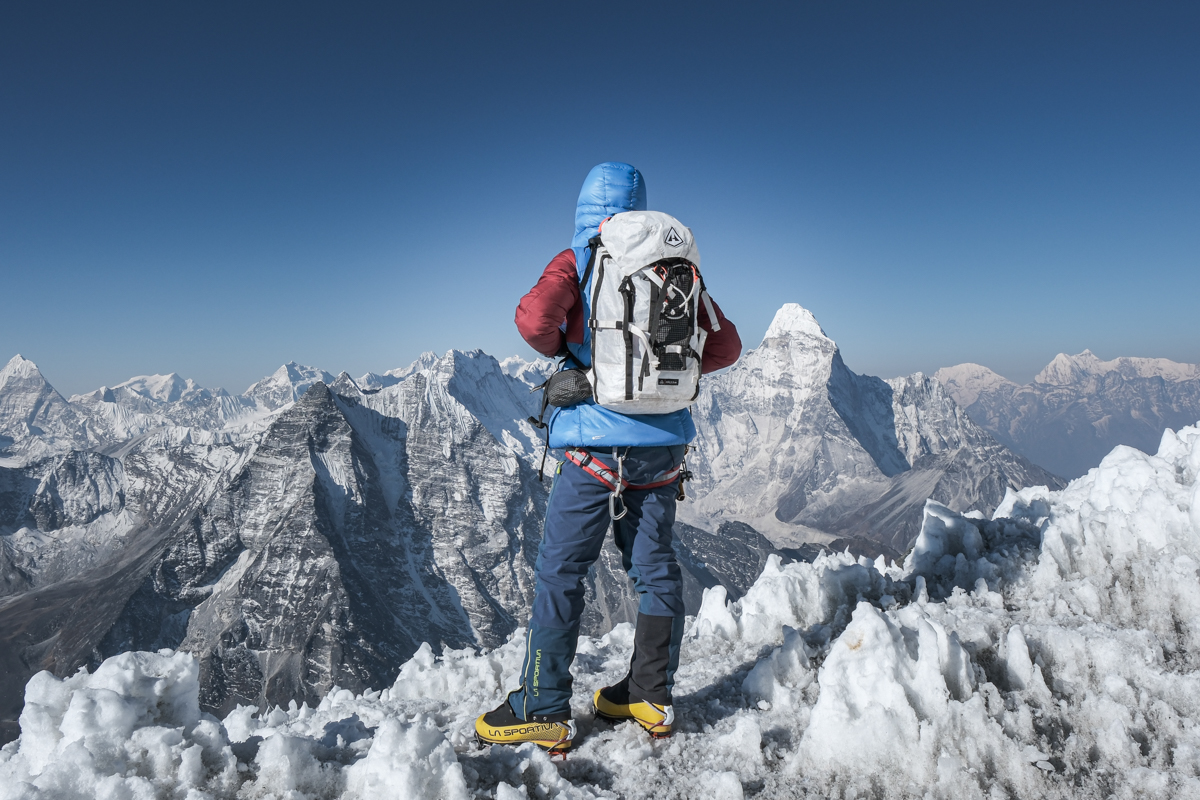
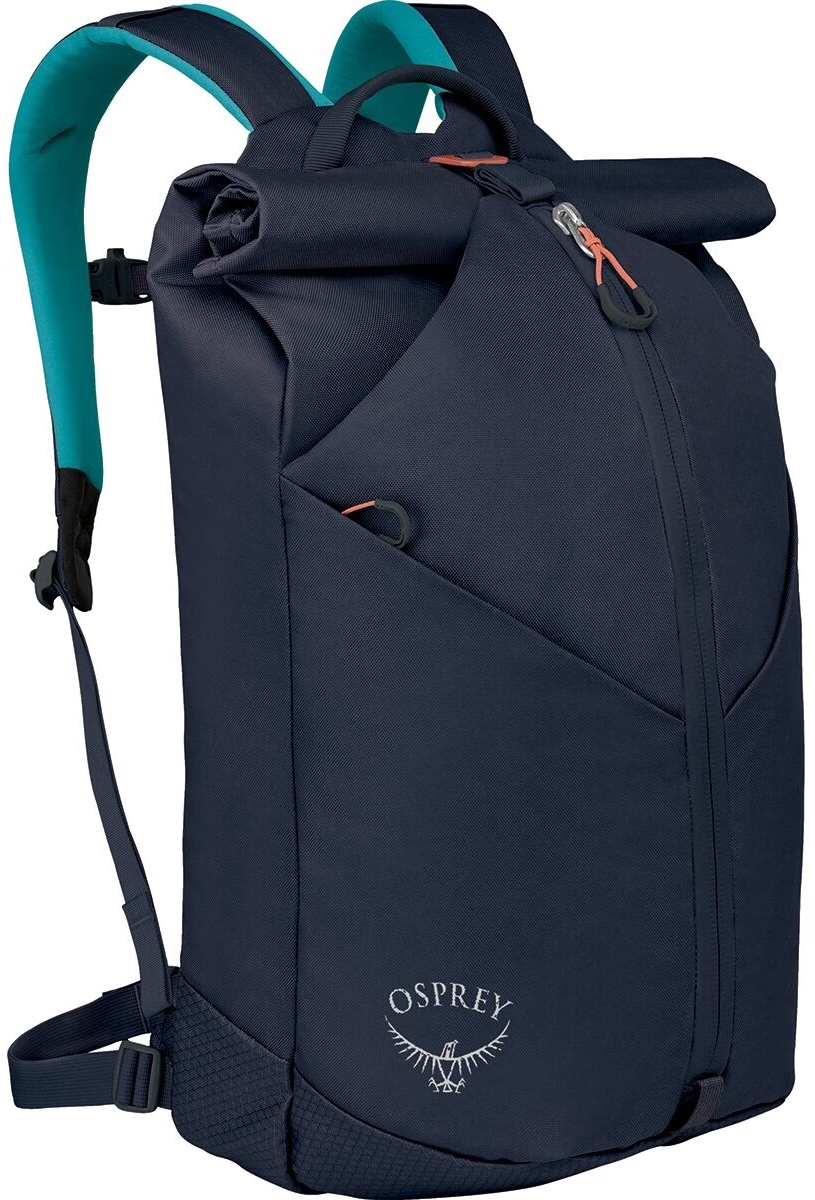 Category: Gym/crag
Category: Gym/crag
Weight: 1 lb. 15.4 oz.
Capacities: 30, 45L
What we like: Dual compartments keep your chalky gear separate.
What we don't: Not large enough to tote a rope.
Nothing beats the experience of climbing outside on real rock, but the gym is an incredible resource when you’re stuck in town. And while any old pack will get the job done, Osprey’s Zealot 30 is purpose-built for the work-to-gym commute. This pack’s best feature is its organization: Dual compartments allow you to store your chalky (and smelly) climbing gear separate from items like a laptop, hydration reservoir, or food. The climbing-gear pocket can be accessed via a long front zipper, and a roll-top closure opens both compartments (the rear features a sleeve for a laptop or reservoir) and expands to accommodate oversized loads. For the modern climber, it’s a really nice solution.
As we mentioned above, Osprey knows how to make a solid pack: Everything else about the Zealot is top-notch and thoughtfully built, including the two external pockets (one with zipper closure), internal pocket with carabiner loop, and bike light attachment. It’s also built to withstand day-in-day-out abuse—including wet commutes—with thick 840D ballistic nylon treated with a durable water-repellent (DWR) finish. All told, if you spend a lot of time at the climbing gym, the Zealot 30 is worth a closer look. And for days at the crag, check out Osprey’s Zealot 45, which offers impressive quality, comfort, and a full suite of organizational features.
See the Osprey Zealot 30
 Category: Crag
Category: Crag
Weight: 3 lb. 2.1 oz.
Capacities: 32, 45L
What we like: Durable and allows for great organization.
What we don’t: Can be difficult to close with a full load.
Patagonia calls their latest iteration of a crag pack a “gear dumpster,” and we think that’s an appropriate designation. The Cragsmith’s U-shaped zipper allows easy access to the entire contents of the pack without exposing gear—or the pack’s suspension system—to dirt. It's also lined with a small layer of foam, which helps hold the structure to make loading and unloading easier, and features enough pockets and sleeves to divvy up the essentials and smaller items like belay glasses, tape, snacks, and car keys. With a 420D fabric, the Cragsmith is a strong and well-made daily workhorse that will protect your gear in most conditions.
For the right application, the Cragsmith 45L is close to ideal: It's comfortable, sleek, and even burly and protective enough to serve as a haul bag. But while the Cragsmith is one of our most durable options, it does come with its fair share of compromises. Compared to a top-loading pack like the BD Creek 50, Patagonia’s offering is simply not as convenient. You can’t haphazardly throw heaps of gear into the Cragsmith, and we’ve often seen friends struggle to seal up the top zip with a hefty load. But for sport climbing or when you’re splitting the rope and rack between two people, the Cragsmith is one of our favorite crag packs.
See the Patagonia Cragsmith 45L
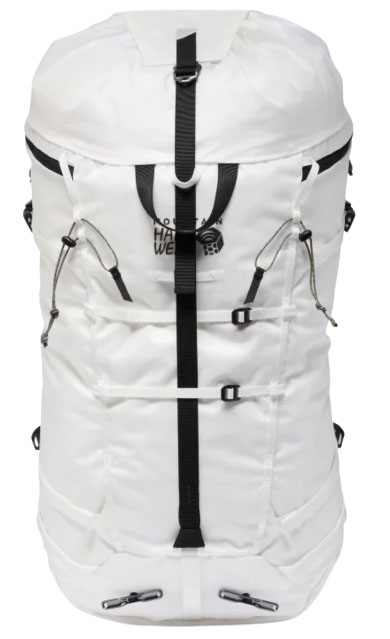 Category: Alpine/cragging
Category: Alpine/cragging
Weight: 2 lb. 2.0 oz.
Capacities: 28, 35, 50L
What we like: Incredibly comfortable and functional for such a streamlined design.
What we don’t: Expensive.
If there’s one pack in our quiver that we reach for more than any other, it’s the Mountain Hardwear Alpine Light 35. For us, this design offers a just-right balance of simplicity and features: The two zippered side pockets are a great substitute for a bulky lid, the carrying system is minimalist yet comfortable, and the external attachment points get the job done (for skis, ice tools, and crampons) without feeling overly obtrusive when not in use. What’s more, we’ve found the pack to carry a load better than most streamlined alpine designs (thanks to the aluminum frame and foam framesheet), and the ripstop nylon fabric is impressively durable and sleek.
The 35-liter Alpine Light has been our go-to pack for approaching multi-pitch climbs (it accommodates a rope, rack, personal climbing gear, layers, water, and snacks with ease), but the cavernous main compartment and nice side pockets also lend themselves to crag convenience. And in a pinch, we’d gladly climb with this pack—the padded hipbelt is removable (a wide webbing hipbelt is a nice replacement), you have the option of taking out the aluminum frame and foam framesheet, and external compression straps cinch down a half-full load. The Alpine Light isn’t cheap, but it’s a nice alternative to the Mutant above for those who want an all-rounder design with a little less weight and bulk. It's also now sold with a handy roll-top closure in 30- and 45-liter capacities.
See the Mountain Hardwear Alpine Light 35
 Category: Follower
Category: Follower
Weight: 1 lb. 2.5 oz.
Capacity: 16L
What we like: A durable and versatile pack for the gym, crag, and everything in between.
What we don’t: Not ideal as a dedicated follower pack.
Take a good look at any crag, climbing gym, or dirtbag hang, and you’re bound to see someone with Black Diamond’s Bullet 16 pack. The Bullet has been around forever and is much loved among climbers, thanks to its durable design, convenient access, and endless versatility. And to be sure: The Black Diamond brand cachet and sleek appearance don’t hurt. Toss in your gym shoes and chalk, load it up with a hydration bladder and snacks for a short multi-pitch, use it to tote your laptop to the coffee shop—whatever your climber lifestyle brings, the Bullet is a great tool for the job.
We love the Bullet as a do-all rig that can pull double duty as a follower pack or light crag pack. It’s incredibly durable with 420D nylon (and 1,260D reinforcements) and even comes with a stowable hipbelt and shoulder straps for hauling up a route. But access is not ideal for multi-pitch efforts: At a hanging belay, you’ll run the risk of losing your gear if you undo the zipper all the way, and you can save some weight with a design like BD's own Rock Blitz above. We also wish Black Diamond had included lash points for attaching gear externally. If that’s a must-have for you, Petzl’s 18-liter Bug and Mammut’s 12-liter Neon Light are viable alternatives, although we consider the Bullet to be the most well rounded of the bunch. Gripes aside, it’s a fantastically versatile climbing pack that’s proven its value over time.
See the Black Diamond Bullet 16
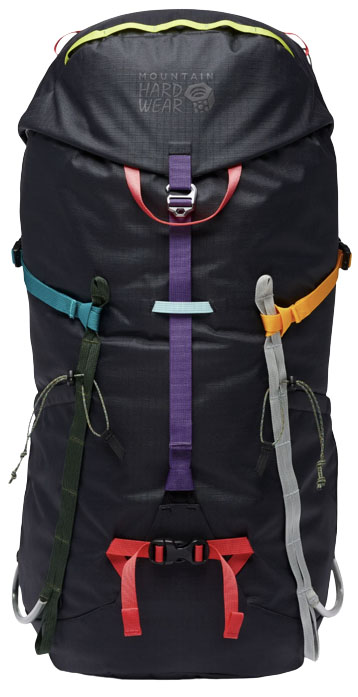 Category: Follower/alpine
Category: Follower/alpine
Weight: 1 lb. 13.9 oz.
Capacities: 25, 35L
What we like: Versatile as an approach or follower pack; functional feature set.
What we don’t: Not super durable and webbing hipbelt limits carrying capacity.
Mountain Hardwear’s Scrambler 25 is an attractive and versatile pack for multi-pitch climbers and those headed into the mountains. Tacking on a bit of weight compared to other packs of its size, you get a fair amount of features—including a removable floating lid, internal gear loop, and side dump pockets—in a fairly streamlined build that sits high on the torso. The result is a pack that offers convenience on the trail but still climbs reasonably well. For approaches and climbs like those found in Red Rock, Yosemite, or even the Bugaboos (the Scrambler has alpine-specific features like ice tool holders and a storm flap over the top cinch), the Mountain Hardwear is a capable all-around rig.
The Scrambler also comes in a 35-liter version, which can accommodate more gear but is less suitable on-route. However, with a similar webbing hipbelt as the 25, don’t expect a high amount of comfort on the trail—and both packs are heftier than the Alpine Light above with 400D (vs. 200D) fabric. Further, the Scrambler doesn't come close to matching the long-term durability of a Dyneema pack like the Hyperlite below, although it'll cost you significantly less. For recreational alpine or multi-pitch climbers or those looking for a hauler that can pull double duty as a daypack, we prefer the Scrambler’s mix of affordability and features.
See the Mountain Hardwear Scrambler 25
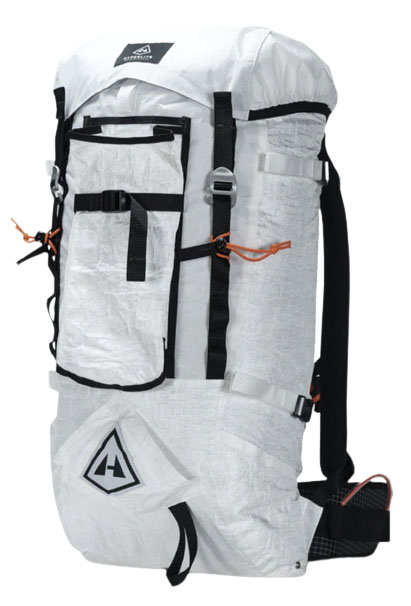 Category: Alpine
Category: Alpine
Weight: 2 lb. 2.6 oz.
Capacity: 40L
What we like: Lightweight and durable.
What we don’t: Drawstring closure and lid is an archaic design.
Dyneema is among the strongest fabrics in the world in terms of strength-to-weight ratio, resists moisture to an impressive degree, and is super lightweight. Suffice to say, we generally trust packs that utilize this material. Along with Hyperlite's own Halka above, the Dyneema-equipped Prism 40 is among the most durable options in our round-up, trumping even the Arc’teryx Alpha FL above. It also compresses better than both with a top compression strap and side straps that cinch the load close to the back and features external crampon carry—a feature ice and alpine climbers will love. To top it off, an aluminum stay, firm foam padding, and a padded hipbelt mean the Prism carries more comfortably than a pack like the Alpha FL.
At $425, the Prism 40 is tied with the larger Halka above as the most expensive model on this list, and it does have its shortcomings. Most notably, we find the drawstring closure and lid to be a fairly archaic design, especially the lid’s Velcro attachment, which makes it difficult to extend with an over-full load. Most of the time, we prefer a pack without a lid for fast-and-light endeavors—it’s simply fewer moving parts to deal with each time you want to access your gear. Second, Dyneema lacks breathability: With nothing to wick moisture between the fabric and the back, you’ll get sweaty in summer heat. But there’s no denying the Prism’s durability, and it’s hard to beat the purpose-built design for climbers hauling tools and crampons. Hyperlite also makes the slightly less durable and heavier Ice Pack 40 ($359), which features a roll-top closure, hipbelt pockets, and a bungee crampon attachment.
See the Hyperlite Mountain Gear Prism 40
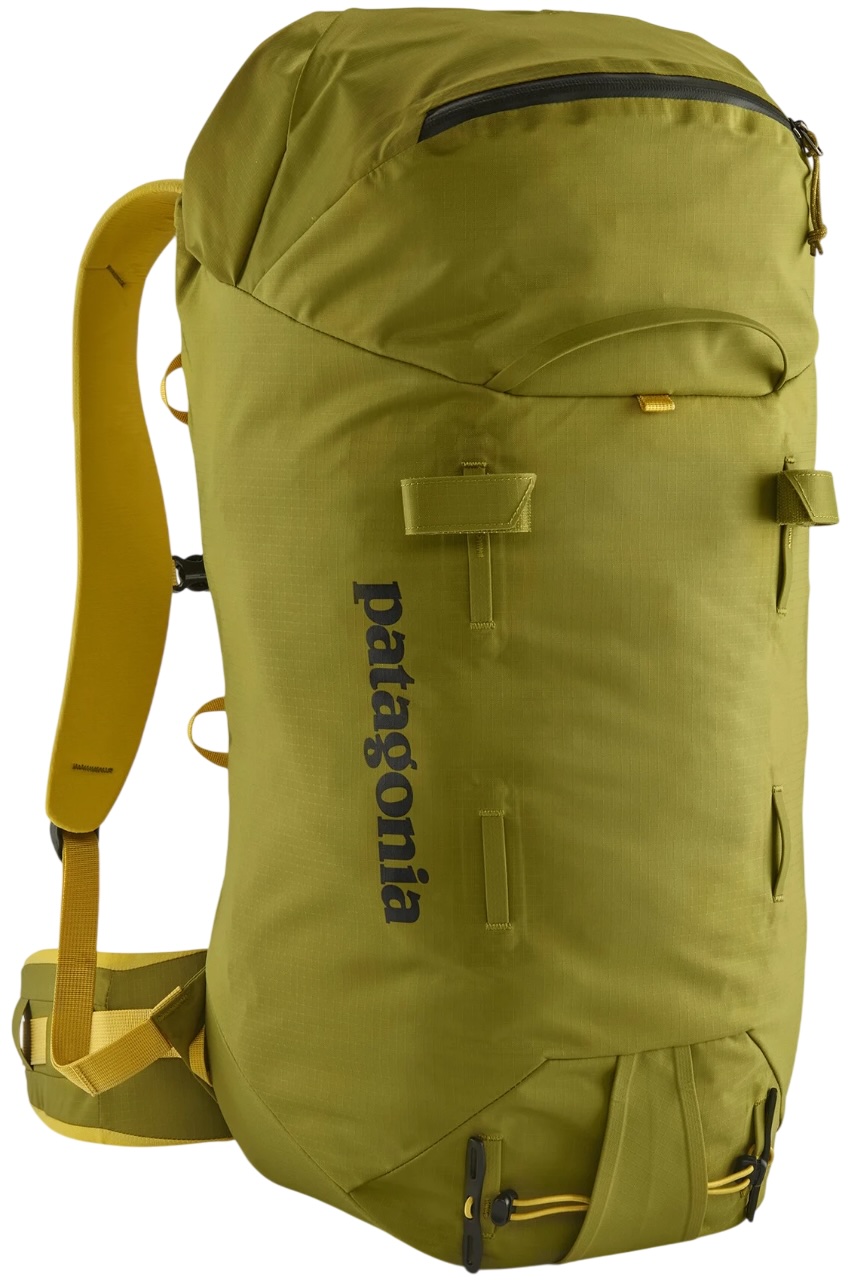 Category: Alpine
Category: Alpine
Weight: 1 lb. 11.2 oz.
Capacities: 35, 55L
What we like: Lighter and more durable than the previous version; a great all-rounder for multi-pitch climbs.
What we don’t: Not as comfortable as the Osprey Mutant or as streamlined as the Arc’teryx Alpha FL.
The Patagonia Ascensionist is designed with both the approach and climb in mind, so it’s no surprise that it transitions almost seamlessly between the two. When loaded down on the hike, a rope strap and side compression straps allow you to attach additional gear. Once you reach the climb, slide the pads off the webbing hipbelt, cinch the bag down tight, and you’ve got yourself a lightweight climbing machine. And at the belay, the Ascensionist hangs from its rear haul loop and allows one-handed access to the main compartment or top zippered pocket.
The Ascensionist has seen several updates in recent years, such as the inclusion of a tall spindrift collar that can accommodate varying loads, secure ice tool attachments, and customizable features throughout. That said, we still have some issues to report: We wish Patagonia had included more storage to supplement the internal stash and single external pocket, and the shoulder straps could use a little more padding for shuttling full loads. Fabric thickness was also sacrificed during the most recent update—down to 210D from the previous version’s 420D—which brought weight down a few ounces but makes the pack less confidence-inspiring overall. These complaints aside, the Ascensionist is an attractive all-rounder that resembles a streamlined version of our top-ranked Osprey but climbs even better (although we still prefer the Alpha FL in this category). For those headed into the mountains on longer trips, the Ascensionist also comes in a 55-liter version built specifically for toting multi-day loads on the approach.
See the Patagonia Ascensionist 35L
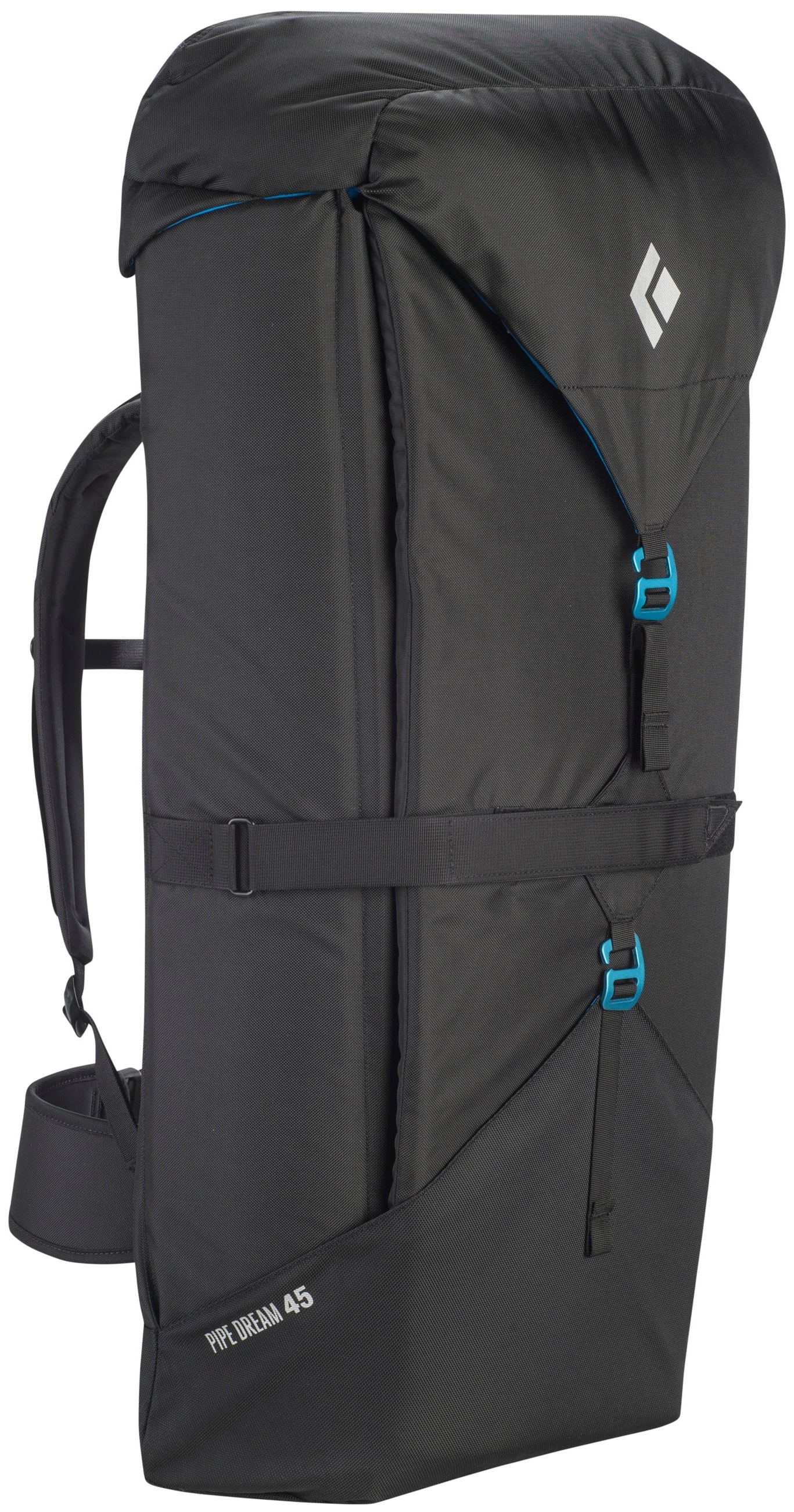 Category: Crag
Category: Crag
Weight: 3 lb. 15.5 oz.
Capacity: 45L
What we like: A backpack that folds out into a padded mat for comfortable crag-side relaxing.
What we don't: Too heavy and unwieldy to carry far; not much in the way of organization.
Where others might be purpose-built for demanding mountaineering objectives, fast-and-light alpine missions, or hauling gear up big walls, the Pipe Dream prioritizes crag-side comfort. Hear us out: With 45 liters of carrying capacity, the Pipe Dream has more than enough room to carry your hardware, rope, and shoes to the crag. But once you get to your climb, it can be opened completely (yes, completely) into a padded mat. This not only allows for quick access to essential gear but also provides a comfy seat for relaxing between redpoint burns. With an 850D body and 1,260D ,base, the Pipe Dream holds up well to abrasive rocks, cacti, and even dog nails (we often see it used as a dog bed, which it's great for). And while the harness system is fairly basic, the shoulder straps and hipbelt are well padded, making it comfortable for short jaunts to and from the car.
That said, this isn’t the pack for long approaches or heavy hauling. For starters, the tall profile results in a pretty unwieldy feel on the trail, especially if you're not intentional about packing the heaviest items first. It’s also quite hefty on its own—in fact, at just under 4 pounds, the Pipe Dream is among the heaviest packs on our list (only topped by the beefy BD Creek 50 above and Wall Hauler below, the latter of which is a dedicated haul bag). And besides the roomy main compartment and a brain—which detaches so you won’t squish your snacks when you sit down—this bag doesn’t have much in the way of organization. In short, the Pipe Dream is a crag pack through and through. But if you’ve got time to kill between burns, want a protected space for your pup, or need to entertain kids at the base of the wall, the Pipe Dream is hard to beat.
See the Black Diamond Pipe Dream 45
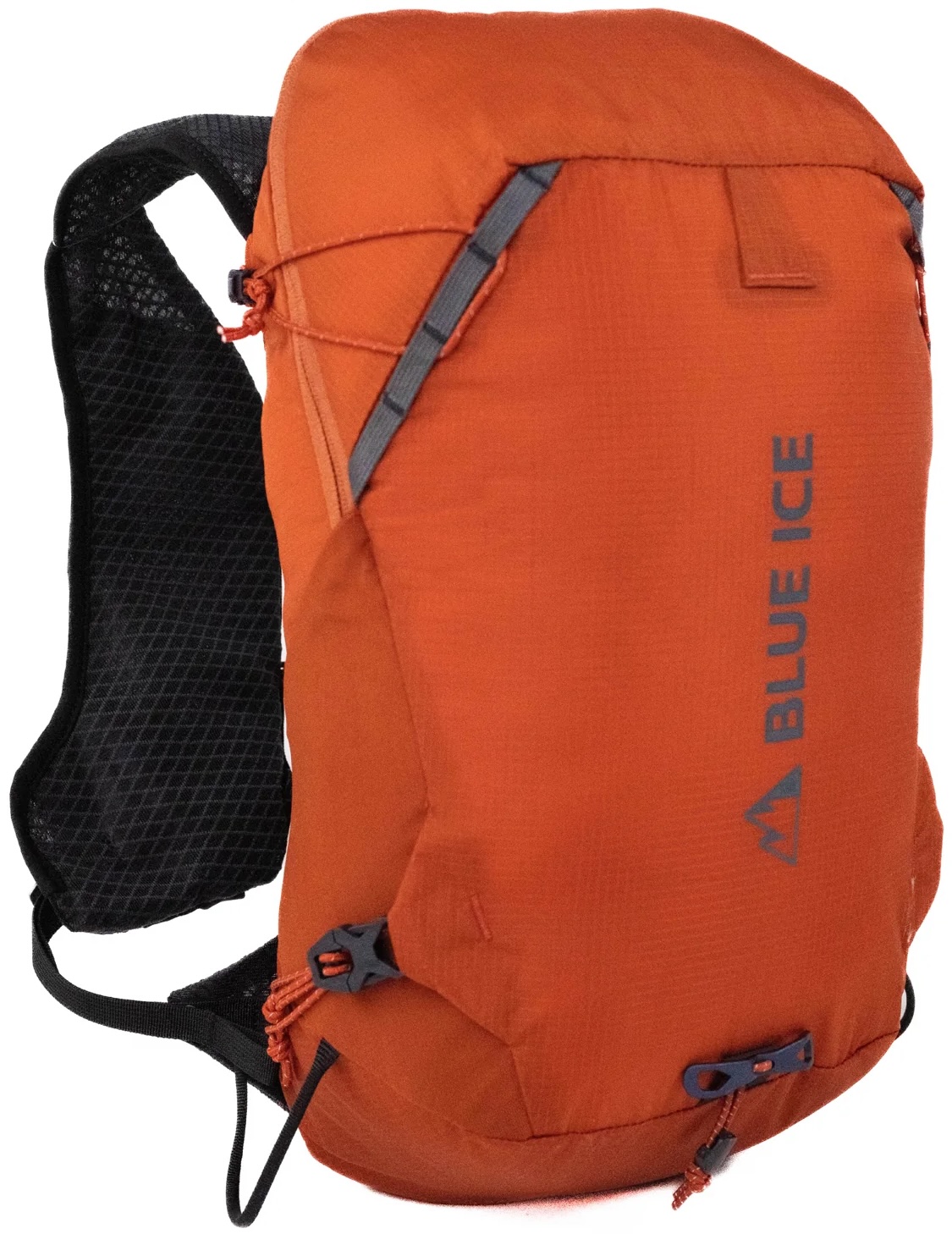 Category: Follower/alpine
Category: Follower/alpine
Weight: 13.9 oz.
Capacities: 12, 20L
What we like: Running-vest-meets-follower-pack design makes it easy to access the essentials while moving.
What we don't: You pay a bit of a premium for the specialized build; relatively thin fabrics.
Running vest-inspired storage is a rapidly growing trend in the pack market, and for good reason: Having pockets at the front of your pack makes it much easier and more convenient to access water, snacks, and your phone while on the move. With that in mind, we were really excited to discover Blue Ice’s Reach 20L. Designed as a hybrid follower/fast-and-light alpine pack, the Reach boasts two large zippered pockets and two stretchy dump pockets at the front for quickly grabbing a sip of water or energy gel while high off the ground or deep in the flow state. The rest of the storage layout is equally well executed, including attachment points for accessories like belay gloves, ice axe loops, and a secure helmet carry system. Impressively, Blue Ice managed to pack all of that in while keeping weight remarkably low.
There's always a trade-off, however, and the Reach isn't immune. One common weight-saving measure is reducing fabric thickness, and Blue Ice opted for relatively thin 100D nylon for the pack body (although it's ripstop, which is notably more tear-resistant than standard nylon). The Reach is also a little complex and pricey, especially compared to streamlined alternatives like the $90 BD Rock Blitz 15 above (which also happens to be much more durable). Finally, we advise sticking to a light load when possible—the Blue Ice's shoulder straps and backpanel offer little in the way of padding, and there's no hipbelt for taking some weight off your shoulders. But we applaud Blue Ice for thinking a little outside the box and consider the Reach a nice option for fast-and-light alpine objectives and multi-pitches that involve mostly crack or face climbing (dragging it up a chimney will almost certainly result in tears).
See the Blue Ice Reach 20L
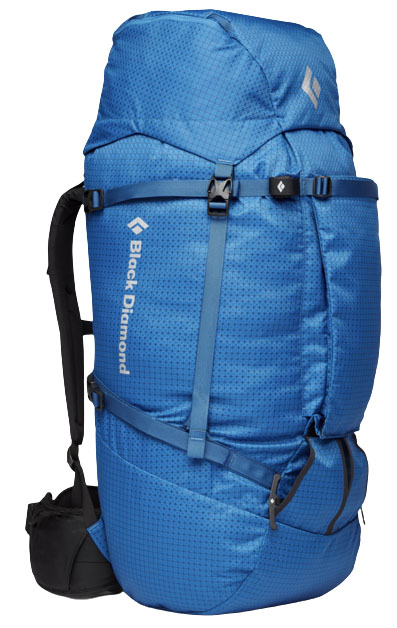 Category: Alpine
Category: Alpine
Weight: 3 lb. 13.5 oz.
Capacities: 55, 75L
What we like: Comfortable, relatively affordable, and updated for durability.
What we don’t: Not as lightweight or waterproof as other alpine packs here.
A true do-it-all pack, Black Diamond’s Mission comes with all the features you’ll need for all manner of mountain shenanigans, including rock and ice cragging, alpine climbing, mountaineering, and even skiing. You get a full side zip for easy access to all your gear, and the strippable design allows you to remove the lid, hipbelt (BD includes a webbing hipbelt), and framesheet for maximum versatility—load the pack down for the approach and streamline it on the climb. And with a fairly recent refresh, the updated Mission features BD's X-rip 420D nylon and a welded crampon patch, making it more durable than ever.
What are the downsides of the Black Diamond Mission 55? At almost 4 pounds, it’s certainly not our top choice for fast-and-light missions, and given the lack of DWR finish, the fabric won't keep your gear dry in a rainstorm like the Halka, Alpha FL, and Prism above. Further, the Mission is lacking internal organization—if you choose to remove the lid, there’s nothing in the way of accessories storage. But aside from these minor gripes, the Mission is a moderately priced pack that may surprise you with its comfort, and it’s been around enough to stand the test of time. For a great quiver-of-one option for those who like to climb in the mountains, we really like this versatile and affordable hauler from BD.
See the Black Diamond Mission 55
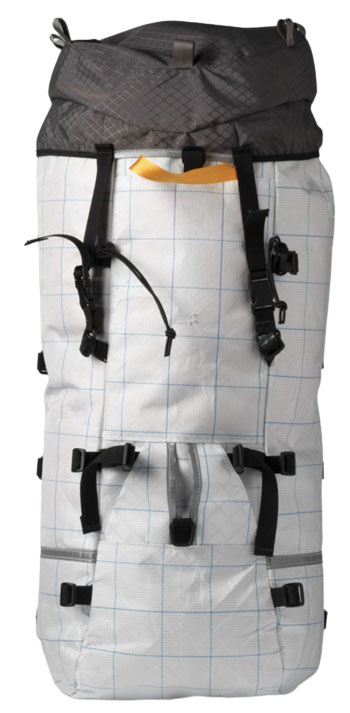 Category: Alpine
Category: Alpine
Weight: 2 lb. 10.9 oz. (1 lb. 8.3 oz. stripped)
Capacities: 20, 30, 45, 60, 75L
What we like: Extremely durable and thoughtfully designed for alpine climbers.
What we don’t: Not widely available and requires time and care to customize.
If anyone in the industry is geeking out about pack materials and design, it’s CiloGear. This quirky Portland-based cottage brand innovates and constructs all of their packs in-house, creatively piecing together materials to maximize both weight savings and durability. The net result is long-lasting packs (we’ve put ours through the wringer for over 10 years) that are also extremely customizable: The lid, hipbelt, compression straps, and backpanel/sit pad are easily removable so you can hike into basecamp in comfort and then strip the pack down into a sleek alpine climbing machine (patience required). As a final bonus, the WorkSack is made from recycled ocean waste, giving the design good sustainability chops, too.
CiloGear WorkSacks range from 20 to 75 liters, and each one is made to expand and compress to fit a range of loads. The 3030 is their most versatile design and our favorite model for alpine missions: It's a 40-liter pack with the suspension of a 30-liter, meaning it can accommodate an overnight kit but streamlines once you’re ready to climb. Compared to the Alpha FL above, it’s a lot more customizable and a better choice for heavier loads, but you do give up the waterproof fabrics, streamlined build, and super low weight of the Arc’teryx. In terms of availability, CiloGear packs are often carried by local gear shops, but we’ve found that their website is the best place to buy (again, patience required). In the end, these packs might not look as sleek as the competition, but they will last a long time and earn you major street cred in the mountains.
See the CiloGear 3030 MOB WorkSack
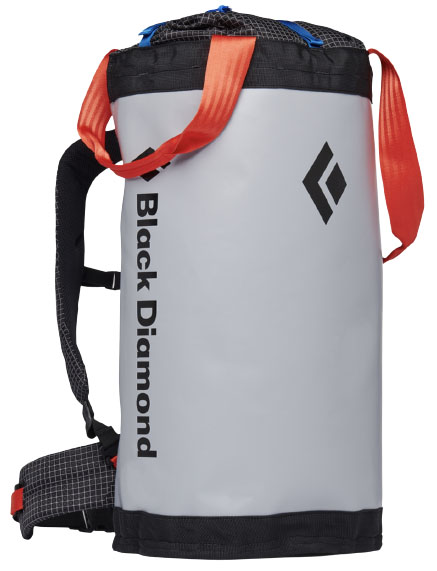 Category: Haul bag/crag
Category: Haul bag/crag
Weight: 4 lb. 6.2 oz.
Capacities: 40, 70, 140L
What we like: Chart-topping durability and functionality for hauling up a wall.
What we don’t: Not the best carrying comfort and limited capacity.
For no-holds-barred durability and functionality, it’s hard to beat a haul bag. Originally designed to handle life on big walls like Yosemite’s El Capitan, haul bags are built with thick, laminated nylon and feature reinforced seams, multiple haul points, and tuck-away shoulder straps and removable hipbelts. In short, they’re incredibly tough to kill. Most haul bags are fairly onerous at around 70 to 100 liters in volume, but we really like Black Diamond’s Wall Hauler 40, which offers just enough carrying capacity for day missions. Whether you’re tagging supplies up a wall for the day or need a durable crag pack for daily use, the Wall Hauler 40 is a great tool for the job.
The Wall Hauler 40 is a big improvement from Black Diamond’s outgoing Stubby, with ergonomic shoulder straps that go a long way towards increasing carrying comfort. That said, it still can’t compete with a pack like the Creek 50 above, which features a padded backpanel and a few different size offerings. It’s also worth keeping in mind that 40 liters can be on the small side for cragging, especially if you’re carrying a full rack and rope (again, the Creek 50 is the superior offering here). Black Diamond does sell larger 70- and 140-liter capacities, although they're decidedly overkill for everything except serious big-walling. For cragging and uses like schlepping around heavy and sharp hardware for cleaning or bolting routes, the 40-liter version here is our top pick.
See the Black Diamond Wall Hauler 40
| Backpack | Price | Category | Weight | Capacities | Fabric |
|---|---|---|---|---|---|
| Osprey Mutant 38 | $200 | Alpine/crag | 2 lb. 8.3 oz. | 22, 38, 52L | 210D nylon |
| REI Co-op Flash 18 | $40 | Follower | 9.5 oz. | 18, 22L | 70D nylon |
| Black Diamond Creek 50 | $240 | Crag | 4 lb. 6.7 oz. | 35, 50L | 1,200D polyester |
| BD Rock Blitz 15 | $90 | Follower | 14.2 oz. | 15L | 840D nylon |
| Arc’teryx Alpha FL 30 | $280 | Alpine | 1 lb. 6.9 oz. | 20, 30L | 315D & 100D nylon |
| Hyperlite Halka 55 | $425 | Alpine | 2 lb. 11.5 oz. | 55, 70L | 150D Dyneema, 210D nylon |
| Osprey Zealot 30 | $130 | Gym/crag | 1 lb. 15.4 oz. | 30, 45L | 840D nylon |
| Patagonia Cragsmith 45L | $229 | Crag | 3 lb. 2.1 oz. | 32, 45L | 420D nylon |
| MH Alpine Light 35 | $275 | Alpine/crag | 2 lb. 2.0 oz. | 28, 35, 50L | 200D nylon |
| Black Diamond Bullet 16 | $90 | Follower | 1 lb. 2.5 oz. | 16L | 420D nylon |
| MH Scrambler 25 | $180 | Follower/alpine | 1 lb. 13.9 oz. | 25, 35L | 400D nylon |
| Hyperlite Prism 40 | $425 | Alpine | 2 lb. 2.6 oz. | 40L | 150D Dyneema |
| Patagonia Ascensionist 35L | $229 | Alpine | 1 lb. 11.2 oz. | 35, 55L | 21D nylon |
| BD Pipe Dream 45 | $150 | Crag | 3 lb. 15.5 oz. | 45L | 850D & 1,260D nylon |
| Blue Ice Reach 20L | $180 | Follower/alpine | 13.9 oz. | 12, 20L | 100D nylon |
| Black Diamond Mission 55 | $280 | Alpine | 3 lb. 13.5 oz. | 55, 75L | 420D nylon |
| CiloGear 3030 WorkSack | $499 | Alpine | 2 lb. 10.9 oz. | 20L to 75L | UHMWPE |
| BD Wall Hauler 40 | $210 | Haul bag/crag | 4 lb. 6.2 oz. | 40, 70 ,140L | Unavailable |
Whether we're placing gear on multi-pitch climbs high in the alpine or pulling on plastic at the gym during our lunch breaks, most of us at Switchback Travel identify as climbers. Former senior editor Jenny Abegg started this list in 2019 with 16 packs. An accomplished mountain athlete, Jenny has used and abused countless climbing packs over the years in pursuit of perfect granite, from local romps in Washington state to towering spires in Patagonia's Chaltén massif. Editor Maddie Downie currently manages the guide. Based in Bellingham, Washington, Maddie is spoiled by the plethora of high-quality crags at her fingertips, from Squamish to Leavenworth, Index, and the rugged North Cascades.
Our current lineup of 18 packs has been whittled down by countless hours of testing, researching, and soliciting feedback from our experienced team of gear testers. When we test climbing packs, we stuff them full of gear, water, snacks, and layers and shuttle them along faint climbers’ trails, toss them in the dirt at the crag, and—in the case of follower packs—haul them up multi-pitch routes. Weight is often at odds with carrying comfort and durability, so we look for packs that effectively balance those conflicting priorities. Features also matter, and we love designs that boast practical storage layouts and quality components that hold up well over time. As the market evolves and new packs become available, we’ll be sure to update the list above to reflect our favorites.
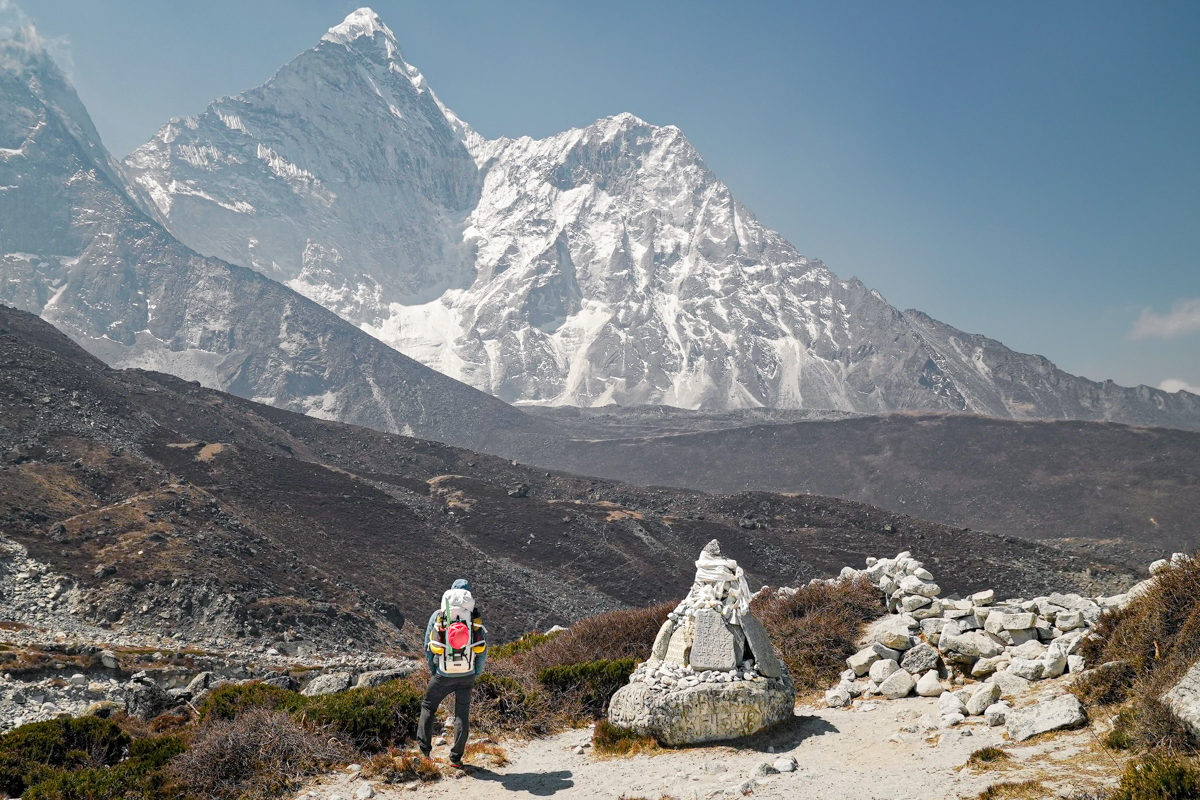
Whether you’re hiking five minutes to hang out at the crag for afternoon, taking 48 hours to ascend a towering granite spire in Patagonia, or free climbing at your limit with a day’s worth of supplies, the right pack can make all the difference. To help, we’ve broken down our favorite models into three main categories: crag, follower, and alpine. We've also included one haul bag on our list—the Black Diamond Wall Hauler—and share a bit on that category below, as well.
Crag Pack
In general, cragging often means walking between five and 20 minutes and posting up in one location for the entire day. You’ll not only need a pack that can carry all your gear and then some, but one that organizes it well too. Crag packs are designed with an emphasis on comfort, easy access, and durability. Some, like the Black Diamond Creek 50, have haul-bag-style bases for simple loading, while others like Patagonia Cragsmith are designed with unique back or front openings for access to all your gear at once. Look for organizational pockets, comfy suspension systems, and even crag-specific features like built-in rope tarps, gear loops, or guidebook compartments.
.jpg)
Most crag packs carry 40 to 50 liters, so you can fit a double rack, your down jacket, and maybe even a couple of post-send beers. Ideally, you should be able to fit all of your day’s gear inside the bag. While carrying a rope and ice equipment on the outside of your alpine pack makes sense for mountain expeditions, there’s no reason to deal with that sort of inconvenience at the crag. Get a pack that can swallow all of your gear easily without needing to stuff all the nooks and crannies or dangle things on the outside. And if you don’t carry trad gear, you can likely get away with a lower-volume bag.
Follower Pack
Follower packs are designed to carry a day’s worth of supplies—water, food, sunscreen, extra layers, etc.—while accompanying you on a multi-pitch route. But buyer beware: “Follower pack” sometimes can be a misnomer. Most parties will climb with one 16- to 30-liter pack (carried by the follower), although the leader often will carry a small pack as well on overnight or alpine routes. Others who are free climbing long routes at their limit might choose to haul their “follower” pack rather than climbing with a bigger load.
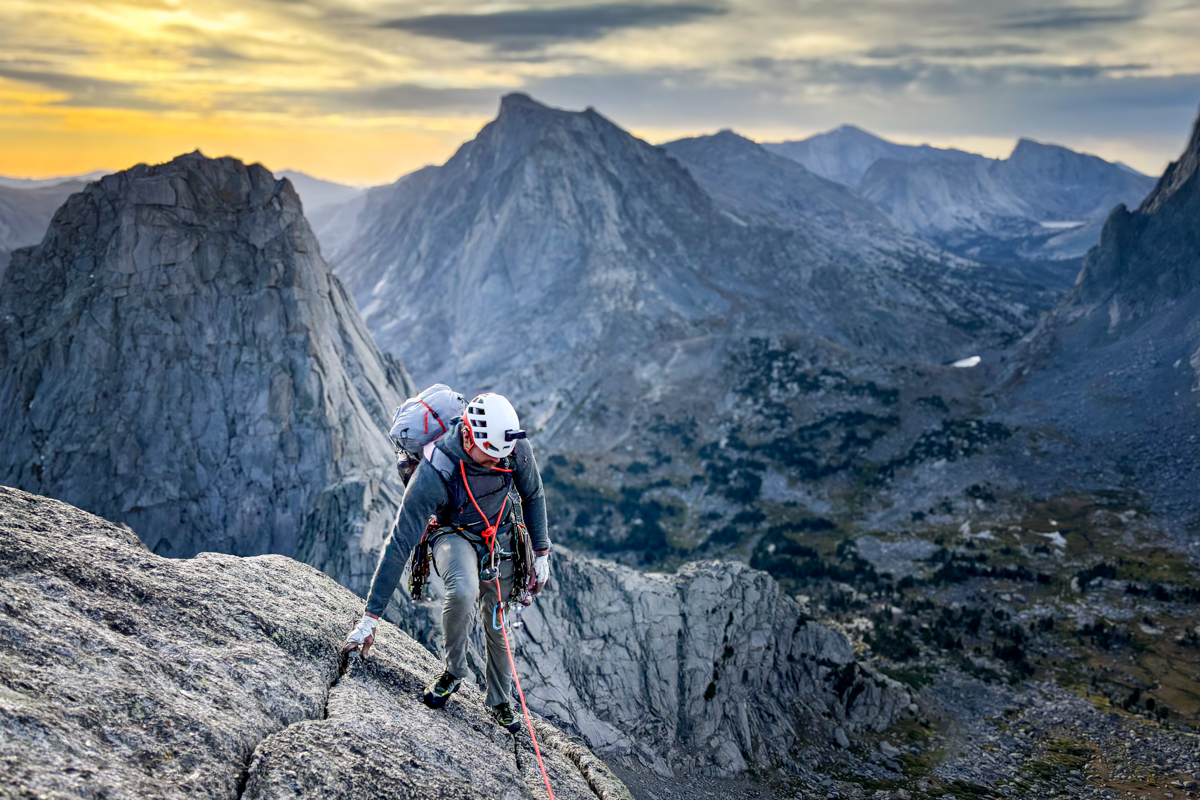
Follower packs are identified by their small capacity—generally between 16 and 30 liters—and have features like easy-to-access exterior pockets, reinforced haul loops, streamlined webbing hipbelts (or no hipbelt at all), and one-handed top drawstrings for quick retrieval of gear at the belay. Some are made with a focus on low weight and packability, while others (like the Black Diamond Rock Blitz 15) are made with high-denier fabrics for durability while scraping through chimneys or being dragged up thousands of feet of coarse granite.
Alpine Pack
When it comes to alpine packs, the focus is less on comfortable suspension systems and organizational features and more on weight savings and versatility. Because an alpine pack needs to be useful for both hiking and climbing, most have the ability to streamline, including features like removable lids, hipbelts, and compression straps (for more, see our section on “Streamlining Your Pack”). Some also come with shock cords or accessory straps for securing crampons, ice axes, or other bulky gear to the outside so you can hike with a massive load and strip down to a tight pack for the climb.
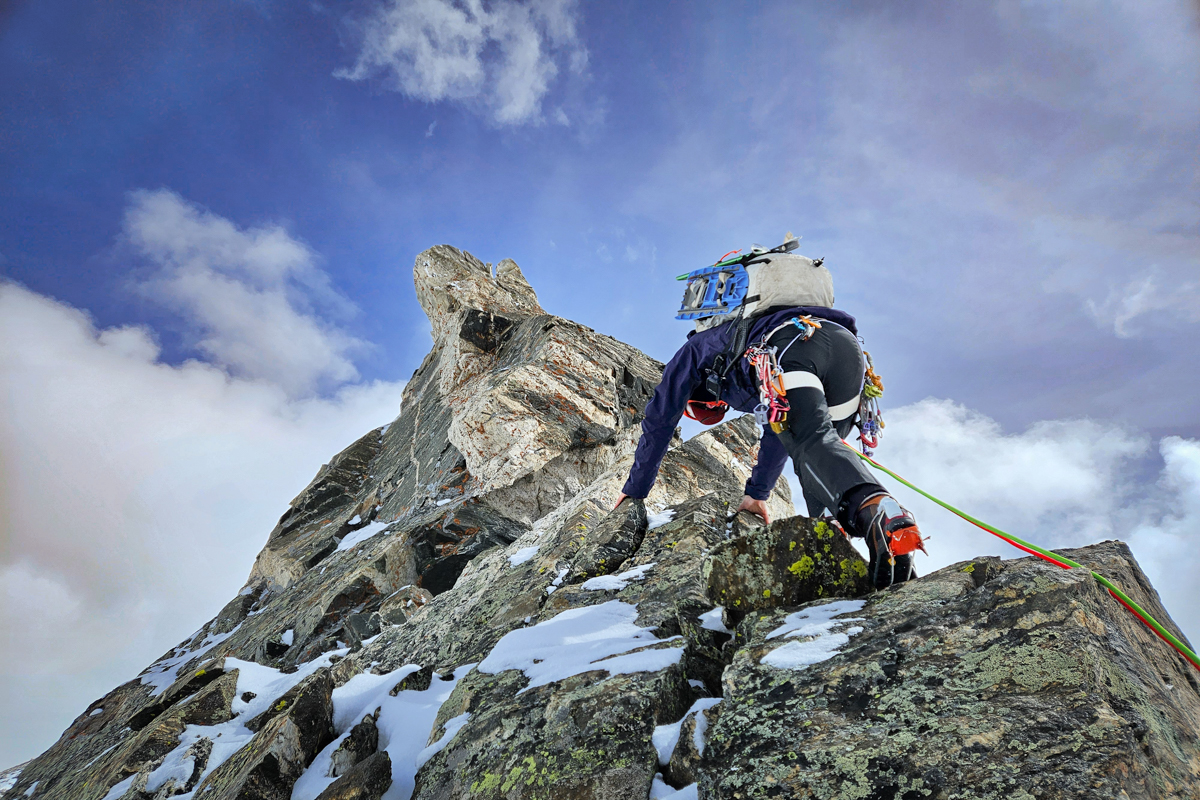
Alpine packs range from 30 to 60 liters, and most climbers will err on the smaller side to avoid added ounces and poor weight distribution. In general, stay in the 30-liter range for a day trip, 45 liters for an overnight, and 60 liters for multi-night trips when you’re carrying many days' worth of supplies into basecamp. And be sure to pay attention to load limits—they’re crucial for comfort on the trail. It’s surprisingly easy to overload an alpine pack with a rope, ice tools, crampons, and climbing helmet, but hiking with 40 pounds of gear in a pack that’s only designed to carry 30 soon will feel severely strenuous.
Haul Bag
We’d be remiss not to also mention haul bags here, which were originally built for toting (literally, hauling) supplies up big walls like Yosemite’s El Capitan. Haul bags are the toughest of the lot, with thick, laminated nylon and reinforced seams that prioritize durability over all else. They generally feature one cavernous compartment (organization is not their strong suit, but most big-wall climbers will use a variety of stuff sacks to keep gear sorted inside), multiple haul points, tuck-away shoulder straps, and removable hipbelts. The majority of haul bags are around 70 to 100 liters in capacity, but those designed for day use—like the Black Diamond Wall Hauler 40 above—accommodate about 40 liters’ worth of gear. We don’t recommend haul bags for those who plan to hike long distances, but for life in the vertical, you won’t find a more purpose-built option.
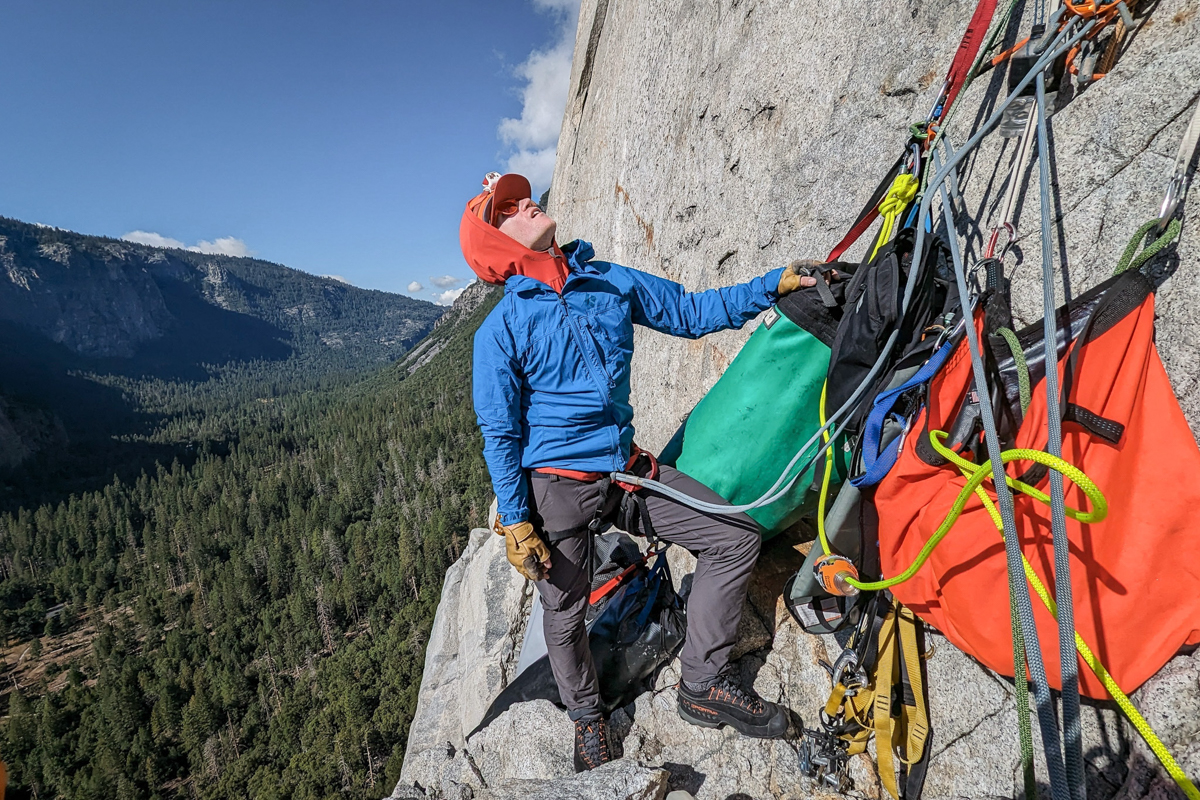
We see a lot of folks using backpacking packs or hiking daypacks at the crag, so we thought we’d address the question head-on: Do you really need a climbing backpack? If you’re just getting into the sport or only get out a few times a year, the answer is no—save your money, save the planet, and use what you already have. That said, for dedicated climbers, the merits of a purpose-built climbing backpack are many.
While most backpacks aren’t meant to be tossed around and hauled up rock faces, the majority of climbing backpacks are built incredibly tough and should last you season after season of use (our Black Diamond Creek 50 is on its 10th season and still going strong). They also feature simple builds with minimal straps and streamlined carrying systems, which is what you want for short walks to the crag or climbing 5.10 in the alpine. Finally, it’s hard to beat the features you get with a climbing-specific pack, including reliable haul loops, convenient crag organization, one-handed drawstring closures, and more. We’re big fans of cutting down on consumption whenever possible, but if you spend a lot of time climbing, the answer is yes: You will seriously benefit from a dedicated climbing backpack.

When it comes to gear you’re carrying on your back, weight matters. That said, it's much more of a concern when you’re climbing 2,000 feet of 5.10 in a day compared to a five-minute walk to the crag. Because of this, crag packs sacrifice a bit of weight-saving for organizational features, comfort, and durability, while follower and alpine packs shave off heavy fabrics, pockets, and cushy suspension systems to be fast and light. As always, be aware that there are sacrifices when shaving weight. If minimizing ounces is not your top priority, you should consider the slightly heavier, more durable, and more comfortable options.
.jpg)
In general, our three categories above provide general guidelines for capacities: Follower packs are about 16 to 30 liters, crag packs are in the 40-to-50-liter range, and alpine packs anywhere from 30 liters for a day mission to 60 liters for a week. It’s important to think about what you intend to stuff inside—a pack that’s too small won’t fit your necessary gear, but a half-empty pack is a waste of material and likely won’t evenly distribute your load. We’d rather err on the side of a too-large crag pack, but prefer our alpine packs to be fully stuffed, even with gear attached to the outside. This is one reason we really like Arc’teryx Alpha FL 30—it’s a 30-liter pack with the ability to fit 37 liters when the need arises.
Durability always is a consideration when it comes to outdoor gear, but it matters even more when it comes to items that are constantly dragged across rock and dropped on uneven surfaces. While some climbing packs are designed with an emphasis on durability, others sacrifice a bombproof exterior to shave weight. The materials used to construct any given pack will help you determine if it suits your purposes: The thin, 70D nylon of the REI Flash 18, for example, makes it a clear choice for a lightweight bag, but it will shred quickly when hauled up rough rock. The Black Diamond Rock Blitz 15, on the other hand, is made of burly 840D nylon, which is perfect for hauling but almost 5 ounces heavier (and less compressible) than the Flash.
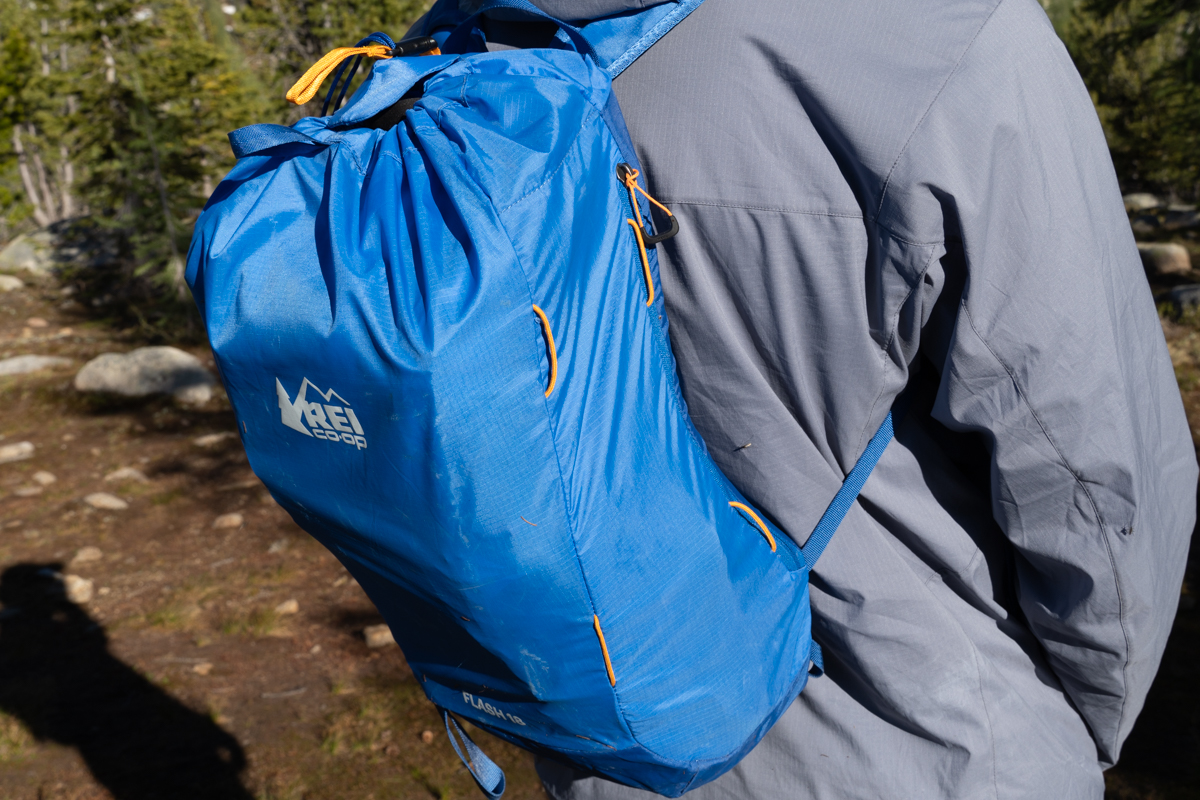
Because rock climbing generally is a fair-weather activity, most of the packs here are not made to be highly water-resistant or waterproof. Those who climb in the mountains, however, might find value in a more protective pack. The Hyperlite Halka 55, Arc'teryx Alpha FL, and Hyperlite Prism 40, for example, are made with waterproof or highly water-resistant materials.
The three types of packs will also often vary significantly in terms of carrying comfort. For the most part, regardless of the pack, you’ll want your load to rest mostly on your hips rather than your shoulders. Crag packs often have fully padded hipbelts, comfortable shoulder straps, and a cushy backpanel that should be able to handle a full load with ease. You can get away with added bulk and weight when you’re only hiking short distances, and will probably find that your load actually feels lighter with the beefy suspension. There’s really no reason not to crag in comfort.
.jpg)
On the other hand, many alpine and follower packs will forgo padding—on the hipbelt and backpanel in particular—for a more streamlined and lighter design. Some maintain a higher level of comfort than others: The Osprey Mutant 38, for example, has a padded hipbelt and shoulder straps, while the Arc’teryx Alpha FL features just a simple webbing hipbelt. In terms of climbing with a pack on, many climbers prefer to have their small follower pack sit high on their back and out of the way of their harness rather than swinging low around their waist. All of the alpine and follower packs we feature have adjustable straps to cater to different body types and carrying preferences.
A pack’s closure system is a great way to identify where it excels. Does it have a one-handed drawstring? It must be made for fast-and-light endeavors when retrieving items from your pack needs to be quick and easy. A U-shaped zip panel on the rear? Sounds like stellar organization at the crag. A removable lid with a drawstring underneath? We’re thinking this would make a great pack to load up for the approach and then strip down for streamlined carry on-route.
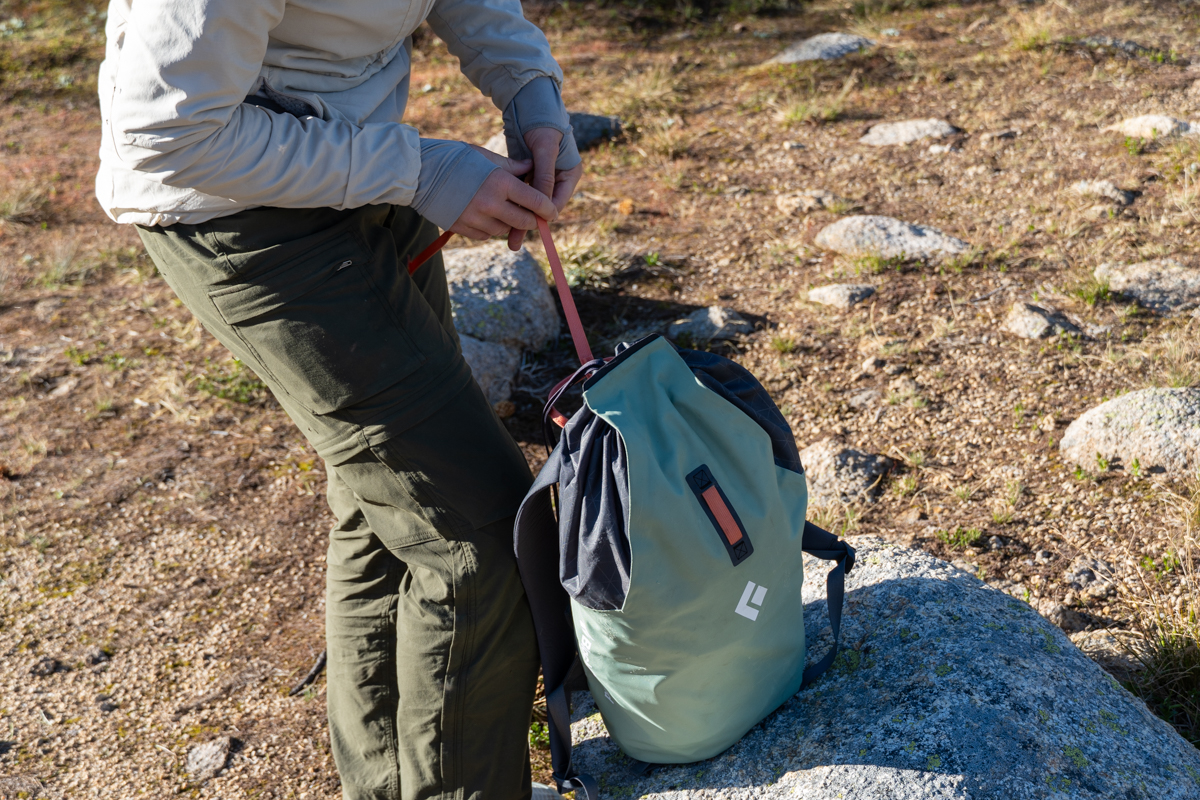
We see the most variation in access when it comes to crag packs, and this is no surprise to us. As we’ve mentioned above, convenience is the name of the game at the crag. Packs like the Patagonia Cragsmith and Black Diamond Stone 42 Duffel are like traveling suitcases, designed to provide easy and organized access to your gear. Conversely, we’d find no need for the convenience of a duffel-style pack in the alpine. In fact, we’d probably spill all our gear trying to open it at the anchor.
Again, we’ll make a distinction here between crag and alpine/follower packs. At the crag, we’ll gladly pay the price in weight and bulk for pockets of different sizes and unique loading and access. Among top-loading packs, duffel-style bags, and full U-shaped panels, it’s generally personal preference. Some crag packs come with built-in gear tarps, and others have internal loops for organizing your gear. Because the approach is shorter, you don’t really need pockets on your hipbelt like you might want on an alpine pack (we think the Patagonia Cragsmith’s design is overkill in this respect).
.jpg)
When it comes to long approaches or climbing with a pack on, climbers are willing to make all sorts of sacrifices in the way of organization shave weight and bulk. Most alpine or follower packs have just one small zippered pocket, inside or out. It might seem too small to be useful, but it’s not. Having quick access to your headlamp or a bar is much better than digging around in the depths of a 40-liter pack at the belay. That said, be wary of zippered pockets on the body of the pack, like that of the Arc’teryx Alpha FL or Mountain Hardwear Alpine Light 35. These pockets are extremely difficult to access while the pack is loaded and cinched down.
Attaching gear to the outside of a pack can quickly go from organized to completely chaotic, so be careful what (and where) you attach. Generally, alpine climbers will carry an overloaded pack on the approach so that once harness, climbing shoes, helmet, rope, rack, and draws have been removed, the bag isn’t unwieldy and oversized on the climb. Most alpine-specific packs come with daisy chains, rope straps, accessory straps, and ice tool attachments for this very reason. Many follower packs also have multiple gear attachment points, which is handy if you’re climbing in Squamish and walking off the summit of the Chief with all your gear. It’s our opinion that once on-route, you should not be climbing with a heap of gear dangling from your pack.
.jpg)
In terms of crag packs, we strongly recommend finding one that can accommodate all of your gear in the inside compartment. Being able to throw everything into a pack allows faster loading and a more comfortable carry. But in the event that you need to hang a tag line or #6 cam from the outside, most crag packs come with a few external attachment points.
If you’re hauling your pack up a climb or hanging it from the anchor at a belay, you’ll want to make sure that it has a strong attachment point. Many climbing-specific packs are made with reinforced haul loops for this very purpose. The Black Diamond Wall Hauler outperforms the rest of our top picks in this department, with large handles that easily meet over the contents of the pack, providing two separate points of attachment for added security. If a pack just has one haul loop—especially if it’s not reinforced for hauling (like that of the REI Flash 18)—we recommend looping a carabiner through both the haul loop and a shoulder strap. Two points of contact—or in climber speak, “redundancy”—is the standard when it comes to safety in the vertical realm.
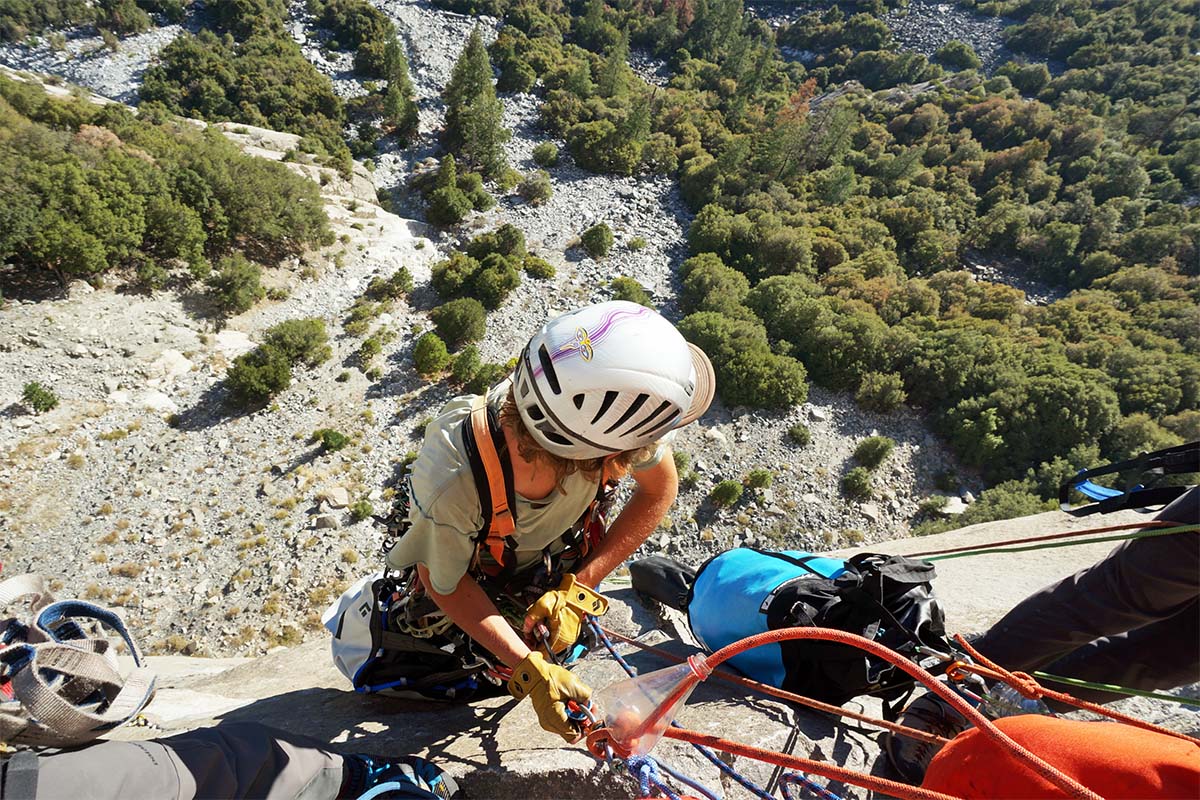
We don’t mention hydration compatibility much in this article, and we have our reasons. For one, craggers likely won’t need to have water on the go during their short commute to the crag. Further, when it comes to follower packs, we don’t recommend climbing with a hydration reservoir’s tube hanging out of your pack. It can get scuffed on the rock or get in your way while you’re reaching for the next hold. And as for alpinists, most climbers we know choose not to weigh their pack down on the approach with liters of water, instead attaching a small .5-liter bottle to the outside of their pack with a carabiner and filling up beside the trail throughout the day.
That said, there certainly are times when it’s nice to have constant access to water via a hydration reservoir. In fact, most alpine and follower packs in this article are hydration-compatible, with the exception of just a couple. Crag packs are a different story—none on our list have a dedicated spot for a reservoir.
.jpg)
More than ever before, outdoor gear brands are making a serious effort to incorporate sustainable production practices. Within the climbing pack market, two of the most common measures we see are recycled materials and PFAS-free DWR coatings that forgo the use of harmful perfluorocarbons. Patagonia has been at the forefront of the sustainability movement for years, and both their Cragsmith and Ascensionist packs above use recycled nylon and polyester (the Cragsmith also has a PFAS-free DWR treatment). Additionally, both packs are certified as bluesign-approved, which indicates that they meet strict health and environmental standards and have been deemed safe for workers, consumers, and the environment. CiloGear’s WorkSack is another standout, touted as the first of its kind to be made from reclaimed ocean waste. Final brands worth calling out are Osprey, REI Co-op, and Blue Ice—all of whom we’ve seen improve their lineups with eco-friendlier materials and practices of late.

Many climbers—especially those headed into the mountains or up a long multi-pitch route—will want a pack with the ability to shed unneeded weight and bulk. Most of the alpine packs here have features like removable straps, lids, hipbelts, framesheets, stays, and more. These components allow a pack to carry more gear on the approach, and then strip down to bare bones for the climb. Essentially, you’ll want your alpine pack to look like a follower pack when you take it on-route: webbing hipbelt, no lid, and nothing more than a light backpanel/bivy pad for suspension. It will not only climb better but will also be much lighter.
Back to Our Top Climbing Pack Picks Back to Our Climbing Pack Comparison Table